Institute awards scholar l iz c heney to deliver lecture
By LIAM PRICE a ssociate news editorThe ansari institute awarded the first annual nasr book prize to australian scholar Tyson yunkaporta sunday night for his book, ‘sand Talk: how indigenous Thinking can save the world.’
The award, according to execu tive director of the ansari institute mahan mirza, was created to “rec ognize an author who’s written a remarkable work and contributes to fresh thinking about global issues.”
yunkaporta, a member of the apalech clan in far north Queensland, australia, said he ex plores global issues from an indig enous perspective in “sand Talk.”

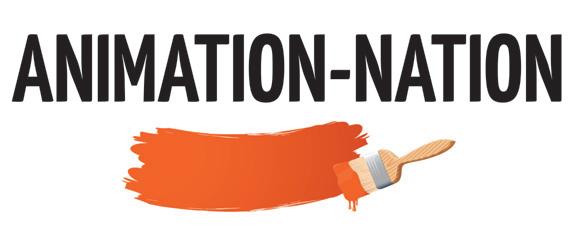
“i’m not sure the book was
Observer Staff Report
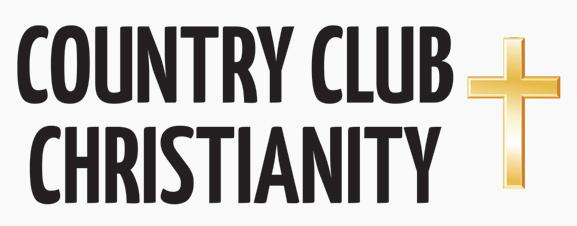
u s rep. l iz cheney will visit notre dame on oct. 14 to deliver a lecture on the future of democracy, according to a university press release.
her speech, titled “saving democracy by revering the constitution,” will be held in washington hall at 2:30 p.m. and sponsored by the center for citizenship and constitutional government.
cheney, who has served as wyoming’s sole member of the house of representatives since 2016, lost wyoming’s republican primary in august to harriet hageman, whose campaign was endorsed by for mer president donald Trump.
currently, cheney serves as
the vice chair of the January 6 committee and is a member of the house a rmed services committee. previously, she served as the third-ranking republican in the house when she was chair of the house republican conference, ac cording to her congressional profile.
The event is free but ticketed for any students, faculty, staff or alumni of the tri-campus. students can pick up tick ets ahead of the event at the laFortune box office, and left over tickets will be distributed at the washington hall box of fice at 1:30 p.m. a lumni can request tickets through a form online. The event will also be livestreamed on the center’s youTube channel.
DIANE PARK | The Observer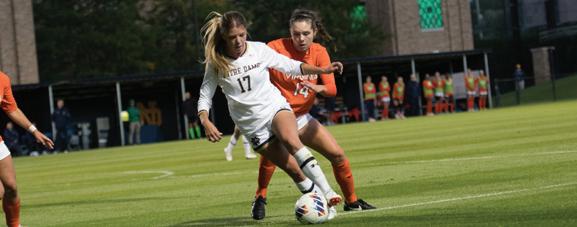
a n early history of parietals at nd
By SPENCER KELLY, CADE CZARNECKI, LILYANN GARDNER and THOMAS DOBBS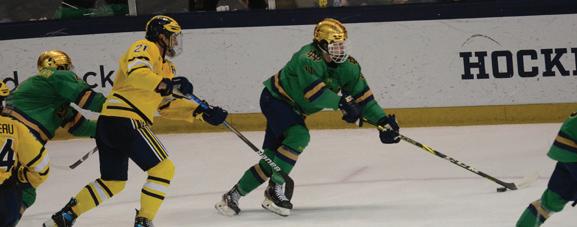 From the a rchives researchers
From the a rchives researchers
This week, From the a rchives continues its cover age on the early history of pa rietals at notre dame. part one ended in 1969 with some early issues and complaints regard ing initial parietal policies, but an overall sense of optimism that this new system would work out.
we pick up our story in early 1970, as the then-all male student body of notre dame increased its calls for expanded hours and more au tonomy over visitation poli cies. w hile the students got some of what they wanted, the administration ultimately drew a line in the sand. The university’s ultimate decision
against hall-determined pa rietals set a powerful prec edent that shaped student life at notre dame for de cades to come, and remains the basic framework for pa rietals half a century later.
Student opinions on pari etal policies
March 10, 1970 | Gary Gereffi | Researched by Cade Czarneckibefore 1970, real discussions about parietal hours were of ten confined to various com mittees and boards. never before had a direct appeal to the undergraduate popula tion been made. To rectify this oversight, the student survey service, established by the notre dame chapter of the national sociological honor fraternity, a lpha Kappa delta, conducted a student survey on parietals.
at the time, the main debate surrounded whether parietal hours were to be made and enforced by the university administration or by indi vidual residence halls. a ran dom sample of students was taken that was guaranteed to be representative. The student survey service ensured that “95 times out of 100 these find ings will not vary by more than 3.5% in either direction from a given result.”
The results were over whelmingly in favor of hall established and enforced parietal hours. i n fact, “only 3% of the sample preferred university established parietal hours, while 68% preferred hall established parietals. a nd hall enforced parietals were favored by 94%.”
The same sentiment was echoed when it came to the responsibility of individual
students. respondents shared that they were almost twice as likely to report parietal viola tions if the rules were set by their hall as opposed to the university.
possibly the most significant question students were asked to respond to was whether or not they would still bring girls into their room if parietal privileges were taken away. seventy seven percent re sponded affirmatively. i n the words of gary g ereffi, direc tor of the student survey, “The responses suggest the inter pretation that parietal hours, ostensibly a privilege, are felt by the students to be a right.”
The final two questions of the survey asked about the nation al image of notre dame. The first dealt with whether or not the removal of parietal hours
College records history
By KATELYN WALDSCHMIDT news writer
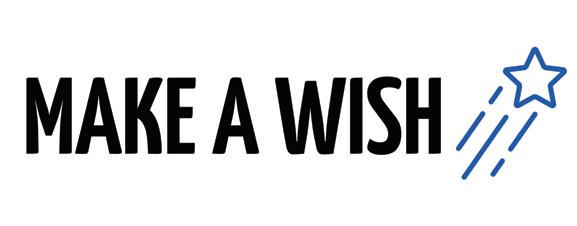
monday night, saint mary’s looked to highlight the struggles of the height of the covid-19 pandemic with a program ti tled, “listening to pandemic narratives: selections from covid-19 oral histories in the south bend area”. The oral pro gram featured audio clips from interviews conducted with mem bers of the south bend commu nity to get different accounts of what pandemic life was like for residents.
“no one’s collecting our sto ries here in south bend,” Jamie wagman, a history and gen der studies professor said. “Julia and i had noticed that other oral historians were do ing these collections but no one was documenting south bend. so we thought, would the sto ries of people here be mirroring national trends?”
make-a-Wish c lub raises money for children
By KELSEY QUINT news Writernotre dame’s make-A-Wish c lub is a small organization of about 20 to 30 active members who share a collective hope to enrich the lives of children in the s outh bend area that face life-threatening medical conditions.
c lub members, who call themselves “Wish makers,” works to raise money to fulfill the wish of one child each year. o n average, this requires fund ing of about $7,000 per wish.
but the wish is only part of the package, according to se nior Lainey Teeters, the club’s chief of staff.
“basically our inspiration is just to make a kid’s wish [come true] in the dark time in their life that is sickness.
And so, sometimes we get to meet the kids, we get to, like, communicate with them throughout their wish. For ex ample, we’ll send them cards and also little things just to get them excited,” Teeters said.
“We really just want to give them something to look for ward to.”
s enior megan c ampbell, the club’s Wish Kid liaison works more directly with the makeA-Wish Foundation, organiz ing the physical wish details, as well as creating events for
the local children waiting for a wish. c ampbell mentioned her own experience that drove her to join the club.
“I know it sounds cheesy, but basically one time my family was at d isney World and we happened to be in line… we were up next and [a family] popped right in front of us. We started talking to one of the Wish Kids who was there get ting their wish granted with their parents. I just always wanted to support the cause ever since,” c ampbell said.
For senior Tyler Knapp, sec retary for the club, make-AWish is a cause near and dear to him.
“my inspiration for joining it was because I was actually a Wish kid,” Knapp explained. “s o, in my junior year of high school, I was diagnosed with leukemia. And I just know, from going through that ex perience, how tough it is on all those kids, there’s no, like, good days for that. s o I really just wanted to give back to ev eryone who helped me out in my experience.”
Knapp described feeling grateful that notre dame has an opportunity for him to get involved with the organization on campus.
“I’m honestly really thank ful for the opportunity to be able to do something like this,”
Knapp said. “I’m so glad that notre dame has a club like this where I can give back so easily. I don’t even have to reach out side of campus to be able to help out.”
Among the various inspira tions of members for joining, all agree on a common theme of “direct impact.” members enjoy knowing how they are helping out. s ophomore Kaitlyn Leshak, the club’s pub licist, explained what she feels is unique about make-A-Wish.
“[ make-A-Wish] is such a big organization, and even though we’re such a small branch, you know that your fundraising is out there working and that people are getting something out of it,” Leshak said.
s ometimes, members even get to experience the effects of the club’s work first-hand. Teeters recalled a couple of the wishes she has gotten to wit ness as part of the club.
“my freshman year we grant ed the wish of someone and it was a best buy shopping spree. And so the club members went to best buy with him and he got a computer, a T v, a bunch of video games, like all sorts of electronics because that’s what he really liked,” Teeters said. “Another one we did, her dream was to be an artist. And so she got to go to the c hicago Art Institute and she got a year
membership and then also had a day where she worked with the team to create art.”
Wishes look different for ev ery kid. For some, their dreams and role models are actu ally here on the notre dame campus.
“We’ve granted wishes for people to come to a notre dame football game. And they get to experience the entire notre dame game day. They get to walk out with the team. They get to experience the locker room, they get to go on the field, they get to do all of that,” Teeters said.
As far as the funding goes towards ensuring these wish es can be granted, the club’s two biggest fundraisers every year are typically notre dame day and their football conces sion stand. The make-A-Wish club also plans various bagel stands, holiday events and res taurant fundraisers through out the year.
c oming up this semester, the club has a few additional fundraisers in the works. o n o ctober 14th, they will be host ing an “egg roulette,” where a couple of professors and stu dents have volunteered to have an egg cracked on their heads — whether it will be hardboiled or regular is up to luck.
Another event on the books for the club is a halloween
Party on o ctober 29th. Teeters explained that there will be a bunch of Wish Kids there en joying trick-or-treating, face painting and fun games.
The club meets every other Wednesday and if students are interested in joining make-AWish, the club’s leadership en courages them to reach out to mawnd@nd.edu.
“We always get a lot of sign ups for the club, but then peo ple don’t feel like they can get as involved,” Knapp explained. “but, [there are] so many little things that you can do that take up very little of your time, but have such a big impact on us in our fundraising efforts and what we do.”
Leshak reiterated the same message.
“This is like so little time, but so much meaning,” Leshak said.
Lainey Teeters ended by describing why, out of all the available clubs, she chose to join make-A-Wish her fresh man year.
“I think it’s important be cause you really do make a direct impact on these kids’ lives,” Teeters said. “In the end, like that is something they’re going to remember for the rest of their lives.”
Contact Kelsey Quint at kquint@nd.edu
arguing anything so much as just really trying to speak from an in digenous worldview,” Yunkaporta told The observer. “but I didn’t bother trying to explain myself and what it meant. I just looked at the world and spoke… from who I am.”
Yunkaporta, in his book, pon ders the importance of intergener ational relationships. The practice of sand drawings in his culture, he said, creates traditions that can remain for far longer than physical data.
“Long after all the books
History
thought, would the stories of people here be mirroring national trends?”
The program was start ed a year ago by Wagman and Julia dauer, an e nglish professor, as well as her stu dents from the spring class ‘doing h istory.’
This course focused on dif ferent historiographical meth ods and students put their new knowledge to use by interviewing south bend resi dents about their pandemic experiences.
“We were thinking a lot about what humanities perspectives
crumble into dust and all the computers are just a geological layer, my children’s children’s children’s children’s children will still be drawing the same thing in the sand,” he said. “That’s the only way to safely store data, it’s in a story, intergenerational rela tionships.” mirza said temporary art, such as sand drawings, best capture how knowledge is con textual. The permanent nature of western textual knowledge, he said, can be damaging because “it’s removed from its point of origin.”
The book passed the new award’s four eligibility require ments, st. olaf college profes sor of religion and philosophy
can offer in times of covid-19 as we continue to process the events,” said dauer. “We were also thinking about how we could better understand and record and preserve some accounts of experienc es in our specific local community of the past two years.”
The unusual presenta tion took its shape from the audio medium. “It’s so powerful hearing peo ple say things in their own words,” said Wagman.
Jaden daher, research and administrative assistant, con curred, saying “You can hear the emotion in everybody’s voices of like going back to this
Anantanand rambachan said at the dinner.
The award required the au thor to have an authentic voice, be academically informed, en gage in contemporary issues of global affairs and have been pub lished within the past five years. After listing each requirement, rambachan quoted “sand Talk” to show how the book qualified.
The Ansari Institute had over 30 submissions for the prize, rambachan said, and the selection committee narrowed the pool of contestants down to five books.
“Then, we read all the five, and we unanimously said this book,” he said.
Along with honoring
time and having to almost re live it by retelling it.”
The presentation started with two minutes of photography from the new York Times that highlighted pandemic life, with pictures of hospitals, social distancing, the black Lives matter protests and other sights associated with early pan demic times. “I feel like we’ve forgotten so much of what happened,” said daher. “This makes it all come back to the front of our mind like, ‘oh my gosh, we did live through that.’”
The audio program be gan with people recount ing the early days of the pandemic, with messages of realization of the horror to come. It then moved on to
Yunkaporta, the dinner featured a “yarn” in which Yunkaporta con versed with carolyn brown, the board chair of the Fetzer Institute, about his book’s message.
Yunkaporta demonstrated the art of sand talks for the audience at the end of the discussion, drawing symbolsinasmallsandboxonstage representing indigenous ideas.
The award dinner, held at the smith ballroom in the morris Inn, was part of a two-day symposium in which scholars from different religious and cultural tra ditions engaged with Yunkaporta’s text in different panels.
While the prize dinner focused on the book itself, the symposium’s panels sought to
different people relating how they had to change their lives once the pandemic hit south bend. A nurse talked about changes in the health care field and starting with the covid unit. A teacher talked about sending chil dren home, not knowing that they were never going to be back in that classroom, as well as the adjustment that came with virtual teaching.
The program continued with sessions called ‘caretaking and equity’ and ‘sociality and Isolation’. The people in these audio clips talked about the struggle and loss of community that came with isolation. A few parents in these clips expressed concern for not only their child’s
foster engagement with the text, mirza explained.
“The larger project is to generate a multifaith conversation around those issues that can somehow be convened by the book that has been published,” mirza said.
mirza noted his belief that notre dame is distinctly capable of flourishing an event like the symposium.
“such an event really is pos sible only at places like notre dame that are both commit ted to academic research and at the same time, where faith is important,” he said.
Contact Liam Price at lprice3@nd.eduphysical but also mental health. If you were not able to attend monday, the program will be publicly displayed for free at the civil r ights heritage center on Tuesday, october 11 at 6 p.m. Additionally, saint mary’s students and staff contrib uted to an exhibit at The h istory museum in south bend. ‘Fight Fear: Pandemics Past and Present’ addresses historical illnesses and the fears that came with them as we experienced covid-19. The dis play is open until July 2023.
Contact Katelyn Waldschmidtdrainage issue termed ‘Lake dillon’ fixed
By SAM GODINEZ news WriterThis semester, the office of fa cilities and design repaired the section between south dining hall and dillon hall, commonly known as “Lake dillon.”
during heavy rain, the area would cause flooding which made it difficult for students to go across the area between the entrance of dillon hall and the exit of south dining hall.
“When [Lake dillon] would flood, it would practically fill that entire sidewalk area,” derick Williams, a sophomore and Keough hall senator, explained.
“It would become this little pond that would form, and everyone would have to walk completely around past other dorms, or they would just kind of brave the water and walk through.”
The flood posed a greater dan ger to people with mobility issues and individuals who ride on bikes and scooters, hunter brooke said.
“For certain groups, I think, it was especially a hazard, especially those with mobility issues, [and] those who have trouble getting around. And the last thing we wanted to see was someone slip and fall and hurt themselves,” brooke, a sophomore and carroll hall senator, said.
both senators explained how the improvements make the
Parietals
con TI n U ed F rom PAge 1would tarnish the University’s national reputation, and the second asked if this should even be a consideration in the parietals debate. s eventy nine percent of students responded “no” to the first question and 82 percent responded “no” to the second.
The sentiment was clear: pa rietal hours, perceived to be a right, should be set by halls, regardless of what the admin istration or the general public may think.
Board of Trustees ex tends parietal hours, hall autonomy
April 16, 1970 | Edmund A. Stephan | Researched by Lilyann GardnerWith notre dame students clamoring for increased au thority over parietals, the b oard of Trustees agreed to loosen their leash, albeit with in well-defined limits.
In April 1970, the b oard announced that they would allow halls to individually de cide women’s visitation hours. however, the outer limit on possible parietal hours was set at 2 a.m. on Friday and s aturday and 11 p.m. on all other days of the week. Further, the halls would be under the regulation of a new hall Life b oard.
The nine member hall
university more inclusive for ev eryone. “We really tried to make sure we’re not forgetting anyone and we’re not leaving anyone out,” brooke said. “It’s just a continual process of making sure everyone has a good opportunity to enjoy their time here.”
brooke and Williams worked closely on the issue once they were elected as hall senators last year, after much discussion regarding Lake dillon.
“For me, it was huge,” Williams said. “It’s definitely something that continually got brought up to me by people that live in Keough.”
The sophomores spoke with Anthony Polotto, director of con struction and quality assurance at the University. “I think one of the biggest things that we can take away is to say that Anthony and his crew over in the construction world for the University are very receptive to students,” Williams said.
The issue regarding the flood ing was the lack of drainage structure. As Polotto said, “After hard rains, we discovered that we lacked some drainage structures to be able to effectively remove the water when we did have hard rains, instead of just letting the ground beside it soak it up.”
To repair the issue, Polotto ex plained, construction installed catch basins tied to the sewer, “to make sure that when it does rain
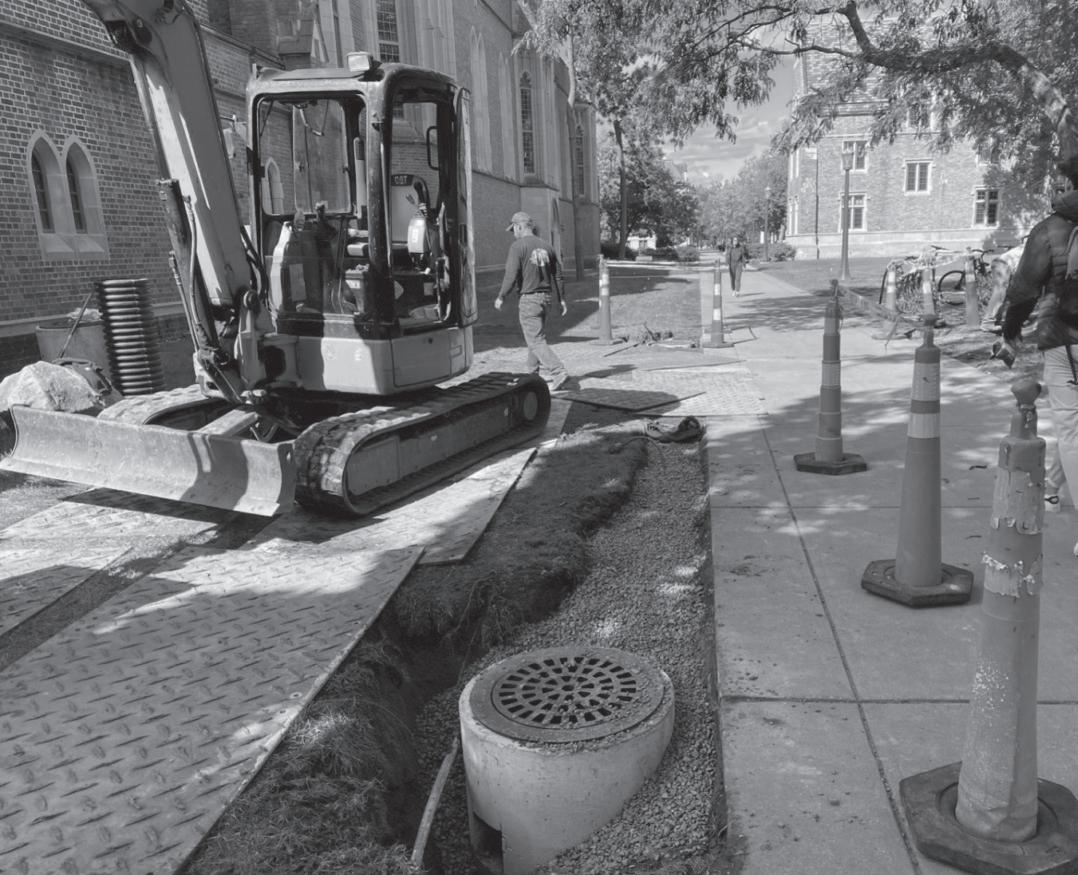
Life b oard, composed of three administration representatives, three stu dents and three faculty members, was specifically cre ated to regulate parietals and other residential life issues as a separate entity of the student Life c ouncil ( sL c ).
“The hall Life b oard will be appointed by the President of the University, and charged with the responsibility of evaluating the proposals of each residence hall board feels [sic] will successfully provide the best hall environment consistent with good order,” observer staff wrote.
The hall Life b oard permit ted hall regulation of parietal hours until a final decision could be made during their meeting in march 1971 with the sL c and b oard of Trustees, but they also maintained that a visitor sign in should be kept in place until that date.
In a statement letter from, e dmund A. stephan, c hairman of the b oard of Trustees, to Professor James massey, c hairman of the sL c , it was emphasized that stu dents should play a larger role in determining the ordering of hall life but only if they are willing to enforce rules in the case of “flagrant violations.”
The rules regarding stu dent life were acknowledged as being able to either aid or detract from hall quality and notre dame traditions, depending on the particu lar hall and hall staff. Thus,
that we can collect the water and divert it away from the site.”
originally, repairs would have been finished before the start of fall break, but the deadline was pushed back to the end of fall break. “We have to identify re sources,” Polotto said. “so there’s a little bit of planning and then you have to do the design work to un derstand what needs to happen.”
In addition, the price of procure ment deliveries has increased. “right now we have to order ma terial and material procurement deliveries are triple, quadruple, what they were a year ago with the current market,” Polotto said. “but there was a full commitment to get it done as quickly as possible.”
brooke and Williams sponsored senate resolution ss2223-08, cosponsored by Pangborn Luca ripani thanking the office of Facilities design and operations for the work they did. The resolu tion passed unanimously. “This was, I’d say, pretty solid unani mous,” brooke said.
A complication both senators had to procure was coordination with the student government.
“There’s so many different branches, there’s so many peo ple and there’s also much of the university,” Williams said. “The University has so many differ ent departments, so many differ ent administrators, that it’s hard to identify who in the university
it was determined that those halls with an established and disciplined fraternal community would need less restrictions and assistance than the halls experiencing disorder.
“The student Life c ouncil has recognized that each residence hall has spe cial problems, requir ing solutions which are peculiar to that hall. It has rec ommended that each hall be authorized to prepare its own suggested visiting hours and enforcement mechanisms under the supervision of a regulatory body, which must ultimately approve or disap prove the hall’s plan,” stephan wrote.
The extended parietal visitation hours, which are reminiscent of today’s parietal hours, were dependent on a mutual understanding that halls would abide by the boards’ expectations of rule enforcement and regula tion. In other words, the University maintained an untrusting attitude toward the students, proving everhesitant to relinquish con trol over parietals to the halls themselves.
Hesburgh denies hall-de termined parietals
Sept. 28, 1971 | Ed Ellis | Oct. 15, 1971 | Fred Schaefer | Oct. 29, 1971 | Observer Staff | Researched by Thomas Dobbs
handles what issue.”
but motivation came from the short time they will spend in the university. “We only have four years to make an impact,” Williams said. “[student govern ment] is so big,” brooke said. “so sometimes it can be hard to reach people. And there’s so many or ganizations to it. so what we’re trying to do is just bring people together so that we can get a lot of people who kind of work hard on stuff like this in one room.”
nonetheless, the senators sat they are thankful for the work that student government did to repair
the flooding.
“We are very thankful for ev eryone in student government,” brooke said. “everyone in student government really understands or really wants to try and help stu dents and improve conditions for the student body.”
constructions on the flood ing have already finished and the only issue remaining is dressing up landscapes, which are ex pected to be completed before fall break.
Contact Sam Godinez at sgodinez@nd.eduexpanded control over pari etals, notre dame students made one last push for full autonomy. o n s ept. 28, 1971, an estimated student crowd of 600 attended an sL c meeting concerning sanctions for viola tions of University drinking and parietal regulations.
The council uncer emoniously referred the report back to the steering c ommittee for revision. students were report edly frustrated by the lack of action. Le mans resident Jackie stone relayed the sentiment with her claim that dean of students Fr. James L. r iehle’s public hear ing was a “token” gesture.
students did not have to wait long, however, for a more meaningful confrontation on University policies. Almost three weeks later on o ct. 15, 1971, the sL c voted to adopt two parts of the hall Life c ommittee report.
The approved amendments outlined sanctions “for as sault, larceny, and the sale or distribution of drugs” and also proposed that “halls be al lowed to determine their own parietal hours.” Their pro posal now awaited University President Fr. Theodore hesburgh’s consent.
The proposal did make an ef fort, albeit a rather vague one, to address potential abuses of hall autonomy. After ap propriating autonomy over parietals to hall leader ship, the sL c first reminded
halls to “construct rules that are in accordance with Indiana state Laws.”
Proposed hall policies would also be subjected to ap proval by a supervisory board, which would base decisions on a hall showing “maturity, responsibility, and the ability to use this freedom wisely.”
The sL c received their response from Fr. hesburgh on o ct. 29, 1971. hesburgh rejected the pari etals proposal, writing that “neither the b oard at large nor I are convinced that it would be either prac tical or wise to leave the determination of parietal hours to the individual halls.”
It appeared that Fr. hesburgh’s reply surprised few students. An observer contributor responded that the University’s decision on parietals “should be greeted by a yawn.”
Unbeknownst to the stu dents at the time, hesburgh’s response cemented an unchanging policy for de cades to come. The University has preserved its jurisdiction over parietals, much to the disappointment of notre dame students over the decades.
Contact Spencer Kelly at skel ly25@nd.edu, Cade Czarnecki at cczarne3@nd.edu, Lilyann Gardner at lgardne2@nd.edu and Thomas Dobbs at tdobbs@nd.edu
don’t talk to me before I’ve had my morning coffee
Aidan Thomas sports editorThe basis of this Inside column started about 10 months ago. As I walked to the back of our lovely office and fired up the Keurig once more at about 4 a.m. This was of course, during the insanity of the brian Kelly exit and ensuing chaos, which led to…more than one all-nighter. That particular Thursday night/Friday morning, we were working on a final timeline of everything that had happened in the past week, and with that monster project due, plus an actual academic project due at 11 a.m., it was a big night for coffee.
The beauties of student journalism, am I right? but the point of this column, written on a rare day following eight hours of sleep, is not to recount the cups of coffee consumed in a desperate effort to stay awake. rather, it is to rank my coffeedrinking experiences on campus over the last 3+ years. much of this ranking will be based on my extremely objective and correct ranking of coffee quality, but also, and certainly rather unfairly, some will be judged on the context in which it was consumed. so sorry to any coffee I consumed in the ungodly hours of 3 a.m. in the library – you won’t rank high. here’s the list, ranked worst to best.
South Dining Hall
It’s hot…some of the times. And it’s not good…most of the time. Anyways, onto the next.
Chick Fil A
I am not here to slander chick Fil A’s sauce. however, I will slander their coffee. It’s easily the worst coffee I’ve purchased with flex points and it’s not close. I’ve gotten it twice, once with sweetener and once without. neither saves it. Bottled Dunkin Coffee from the Huddle
Part of this ranking is contextual. I really have only gotten these during late night hesburgh grinds when a 3 or 4 a.m. bedtime was inevitable. but they’re not great and extremely sugary, which just isn’t my taste in coffee. so I avoid these in most cases.
Common Grounds Coffee
Why hasn’t this reopened? I would like an answer. The convenience factor raises this simple coffee cart way up the list. Although they didn’t have iced coffee, which is my favorite, they had well-made hot coffee with a variety of blends and creamer options. situated right in debart, it was a perfect pick-me-up in the middle of a long day of classes.
Einstein’s Coffee
rIP einsteins. my freshman year place of employment is of course no longer lo cated in the bookstore. einstein’s was my main freshman year coffee. my location in baumer made it a convenient stopping point en route to class. It had a nice selection of hot and iced coffee and their frozen caramel coffee was a fantastic dessert option.
Starbucks
I don’t mean to offend the cult-like following of starbucks, but this only ranks third on my list. It’s good, but it’s not special. I’m also a lifelong dunkin kid, so starbucks has always ranked second on my list. Plus it sucks up flex points when ever I do order it, and it’s not conveniently located to any of my classes, so I rarely order it.
ABP
AbP’s value is off the charts. I don’t know the exact size of the large iced coffee there, but you can fill that sucker up for a touch over three dollars, and it will last me two classes, easily. That’s a great deal and it’s location in hesburgh is convenient to grab as a coffee during extended studying efforts. Plus, the hot coffee is really good. starbucks quality is probably higher, but the value I get from AbP is borderline unmatched.
Hagerty Family Cafe
dating back to Accepted student’s day, hagerty was my first cup of coffee on campus. Their standard hot coffee offering is great, but I love their cold brew. Plus, for those who are fans of seasonal coffee, hagerty’s various lattes, (I can person ally vouch for the apple crisp latte), absolutely slap. no questions asked. Plus, the location in duncan student center is incredibly convenient for me to grab between classes. members of my 11 a.m. digital marketing class this semester could cer tainly vouch for the sheer number of times I’ve come to class with a cold brew from hagerty.
That’s the list. I’ve settled into my coffee drinking routine (plus or minus a few a day, depending on my schedule) but hopefully this might inform your choices as well. Although I’d recommend avoiding the 4 a.m. mcdonald’s K-cup…9 out of 10 doctors say this reflects remarkably bad things about your current sleep schedule.
You can contact Aidan at athoma28@nd.edu.
The views expressed in this Inside Column are those of the author and not necessarily those of the Observer.
Spotting the natural law
Devin Humphreys Life, Law and the Lord
often when I was an undergraduate at michigan state, and occasionally nowadays here at notre dame, friends of mine and I have gathered around a table, and some one has suggested that we play a round of the card game known as chairman mao. I won’t spoil the game for those who have never played (half the “fun” is in introduc ing new players to the game), but essentially chairman mao is a game for those who love rules. more accurately, chairman mao is a game for those who love to make up rules… and not tell anyone what they are… and penalize those who break them. Indeed, the aim of chairman mao is to learn what gets you penalized to avoid penalties and obtain victory. To say any more than that would earn me a penalty in my next game of chairman mao.
Last month, I took a significant shift in my choral direction from years past and joined the notre dame chorale. It has been a true privilege to sing with another one of notre dame’s top-notch choral ensembles, and I’ve enjoyed making another set of new friends and singing solid sacred music and school songs with my choral colleagues. but dear reader, chorale is not just an organiza tion dedicated to performing sacred music and school songs. nay, for the social fabric of chorale is a tapestry woven with many a tradition dating back to time immemorial, and one of those traditions is a little game that members of chorale tend to refer to as “spotting.”
The general rules (for the rules of this game are only ever articulated in general terms) are as follows: members of chorale should acknowledge each other when their paths cross in unforeseen contexts. Failure to acknowledge is grounds for a chorister to snap a candid photo and take recourse in the group chat by posting the photo and tagging the subject, publicly calling out whichever chorale member lacked a keen sense of observation in that given instance. I for one will admit to having been spotted five times last month, a number slightly tempered by the fact that as a newbie to the choir, I’m still learning for whom I need to watch out. I won’t take full responsibility, as sometimes my colleagues spot me in very creative places. how are you supposed to be on guard from being spotted at a dance, for instance? It doesn’t matter — them’s the unwritten, understood rules. sometimes, however, spotting gets a little out of hand. Is it legal, for instance, to spot someone if they’re on their way to re hearsal? before, during, or after mass? What about places you expect to see someone? The answers to all of these questions are not written down, and I dare not write them down here, lest I contradict the point this article seeks to make. but where these and other edge cases arise, I observed a phe nomenon in my fellow members of chorale: a tendency toward self-regulation and the declaration of what the rule has always been and will always be. now, I don’t know why this particular mode of dispute resolution surprises me so much. After all, I’ve written other columns for the observer where I’ve waxed poetic
about the so-called “declaratory theory” of law, by which judges find law rather than make it, and when judges find law, they are able to do so because the law has always been what it is being declared to be. but surprise me it did, and I think to figure out why we have to turn to that ridiculous card game with which I have opened this column. What’s the difference between my chorale friends declaring the spotting rules and players getting penalties in chairman mao?
I think we can find the answer in natural law theory, of all places. The catechism of the catholic church explains that “[t] he natural law is written and engraved in the soul of each and every man” (¶ 1954, quoting Leo XIII’s papal encyclical Libertas praestantissimum). Although there are variations in how natural law is applied in different societies (¶ 1957), and “[t]he pre cepts of natural law are not perceived by everyone clearly and immediately” (¶ 1960), it is this foundational idea that law is bigger than what we write down that underpins both the church’s canon law and (to a lesser extent) the very fabric of our social order. so what does natural law have to do with chorale spotting, or chairman mao for that matter? I offer the following juxtaposition: the rules of chorale spotting are common sense, while the rules of chairman mao are deliberately convoluted. In chairman mao, one only learns the rules by break ing them. The rules are not discernible any other way. on the other hand, if you don’t overthink it, you could go through a year of chorale spotting without running into an issue, snapping photos of your non-ac knowledging compatriots, calling them out in the group chat and having a jolly old time putting names to faces as chorale newbies must.
At the end of the day, I have always been at least a little bit skeptical of the pull of broad, sweeping theories of natural law. even given the catechism’s caveats as to how widely natural law can be applied, I have struggled to understand how we humans are capable of doing such weirdly different things. As st. Paul says in romans, “I do not do what I want, but I do what I hate” — concupiscence is definitely a thing that pulls us away from the natural law. but my skepticism is of more than simply our capacity for doing wrong when we should do good. how are we capable of having such different notions of what “good” even is? I think the answer is that we are all too busy trying to play a game of chairman mao. I’ve been overthinking it the whole time! Instead, we should be aiming to “spot” the natural law, in prayer, in conversations with friends and in simply living our day-to-day lives. may God give us this grace.
Devin Humphreys is a 3L at Notre Dame Law School. When he isn’t serving as the sacristan at the Law School Chapel or competing at a quiz bowl tournament, he’s sharing his thoughts on the legal develop ments of the day with anyone who will listen. For advice on law school, hot takes on Mass music and free scholarly publica tion ideas, reach out to Devin at dhumphr2@nd.edu.
The views expressed in this column are those of the author and not necessarily those of The Observer.
Prioritize and execute
TimeIn my last article, I covered the overarching topic of Jocko Willink and Leif babin’s extreme ownership, and I wanted to follow up with another important leadership principle covered in the book. during an operation in ramadi, Platoon commander Leif babin and his men commandeered a building right in the enemy’s backyard. Their goal was to disrupt the insur gents’ safe haven and weaken their force. Upon entering the building, the platoon faced immediate fire from the enemy. Fortunately, these men had the advantage of high ground, which allowed them to fight back against large numbers and assert their position. While this building had clear ad vantages, it also presented one glaring issue: the stairs to exit the building from the top floor were located outside the building. This meant they could not move up or down when facing fire from the enemy. It also reminded them of a frightening recent event in the area. Another marine sniper team faced similar building conditions. As they were inside the building, the en emy placed an Ied on the stairs, and it detonated as they exited. now the team had to be sure the stairway was clear before returning to base at night. After hours of fighting, darkness swept over the area and the team prepared to leave.
however, their fears had come true. The eod operators located an Ied on the stairs. This meant they needed to find a new way out. The solution was brute force. men with sledgehammers taking on a wall. soon the wall fell and the departure would begin. The eod operators set a timed detonator so the Ied would go off safely where no soldier or civilian could be wounded. After setting the timer, they immediately started moving across buildings to be clear of the blast. however, on top of one of the buildings, a platoon member fell through the ceiling due to a missing piece of concrete hidden by a tarp.
now Leif had to make a decision. Amidst all the chaos, he calmed down and stuck to the principle: prioritize and execute. If they all went running helter-skelter after the fallen man, they could be left susceptible to enemy fire. he wanted to locate and save the man below immediately, but an irra tional rescue attempt would make the entire crew’s survival chances much lower, including his wounded team member. so Leif laid out his top three priorities: set security, find a way off the roof to the wounded man and get a head count before continuing the departure. Quickly, the team ran through the list one by one and made their way back to base safely. by enacting the principle, prioritize and execute, Leif was able to stare down an extremely high-pressure situation and make it more manageable for his team.
While this situation may not be likely for most of us in our lives, prioritiz ing and executing can be a solution to many stressful occasions. With mid terms coming up for most of the school, this can be especially helpful. If you have three tests and homework assignments in the same week, determine everything you must get done each day, then determine the importance of each task and then execute. having this step-by-step mindset allows you to take a large problem and make it seem much smaller through clear, effective prioritization.
Jocko, the co-author with Leif, even related this principle to the business world to make it more applicable for the average reader. When working as a leadership consultant, he helped a ceo determine how to turn around his company’s performance. during the discussion, the ceo rattled off count less initiatives with solid rationale. however, there was one problem: there were too many initiatives. The frontline workers would not understand what to focus on to better contribute to the company’s success. Jocko sug gested the ceo start with priority one, execute, then move to the next one. so the ceo placed all of his focus on his salespeople. If their performance continued to lag, the company would be out of business. Their success was a necessity. soon, the focus on one initiative propelled the company forward and put them in a better position to prosper.
As is evident from these stories, the principle of prioritize and execute settles down an overwhelmed mind. In addition, adhering to it during the small-scale weekly issues we all tend to face will make you better prepared for the larger problems life will inevitably present you. Whether we like it or not, bad days will come, and having a grounded approach will make it much easier to handle them. When problems are getting thrown at you left and right, the best solution is to take a step back, think and determine the best course of action step by step. being able to handle problems, small or large, with a calm demeanor and clear, intended actions is vital to all aspects of life, and I believe that this principle can set the foundation for handling the challenges life throws at you. so the next time you feel overwhelmed by your many responsibilities, I urge you to practice the principle of prioritize and execute.
Mikey Colgan is a sophomore from Boston majoring in finance and ACMS. He can be reached at mcolgan2@nd.edu.
The views expressed in this column are those of the author and not necessarily those of The Observer.
The fate of the unipolar world
Pablo Lacayo reliable ramblingsWhen my friends and I welcomed the new decade alongside the intermittent crashing of waves on the delectable shores of nicaragua’s Pacific coast, we took a moment to predict what the 2020s would herald for our own lives and the potential events that might shape up the world in the years immediately ahead. besides a few very predictable hits along the lines of “graduating” and “running it back the following new Year’s eve,” most of our predictions fell flat and are probably resoundingly laughable at this point in time. surprisingly enough, the only major one we managed to hit on the nail was the high pos sibility that we’d finish college in the midst of a recession, or at the very least teetering close to one.
Predicting the world to come is no easy task and no one can do so with total absolute cer tainty, but a recurring theme regarding the future seems to arise more frequently as the nature of the global world order breaks the mold cast by the circumstances of the end of the cold War: the end of the “unipolar world.” When the soviet Union collapsed in the final days of 1991, the United states emerged as the world’s sole superpower. The bipolarity that had defined the international stage for nearly five decades gave way to American unipolarity. Thanks to the country’s vast net work of international alliances and bilateral partnerships, the United states found itself in a position of primacy, where the defense of her interests could go virtually unchal lenged. It was the perfect storm for the United states to cement herself as the most powerful country in the world, as a mass transition towards democracy in the developing world returned governments that were much more akin to allying themselves with Uncle sam and checking as many items off America’s wishlist as they could: trade liberalization, privatization, free and fair elections and easi er paths for foreign direct investment.
Up until this year, I had never heard of this concept, but became invested in it after it became one of the President of russia’s favorite topics to spew vitriol against since the start of the russo-Ukrainian War back in February. Throughout many of his speeches, especially those directly related to the on going war, President Putin has repeatedly stated his wishes for the world to do away with American unipolarity. back in August, he asserted that the current unipolar model, which he considers obsolete, will be super seded by a new world order. Last week, he blasted the West, saying it was doomed and promised “a liberation anti-colonial move ment against unipolar hegemony.” beyond the propagandistic value of his statements, made to assuage domestic concerns regard ing russia’s underperforming military, does Putin make a valid point regarding receding American influence?
To an extent, America’s standing on the world stage is not the same as it was in the recent past. russia’s desire to hold former soviet republics in a tight clutch, combined with china’s aggressive push to extend its influence into the developing world through both hard and soft power definitely weakens unipolarity, as it creates additional bands of nations that seek to act on a different set of interests than Washington’s. All that is
predictable, as russia and china have never been on the best of terms with the United states. however, what about the rest of the world, where the United states sways sizable influence? As other countries grow and con solidate their power, they naturally become more confident in moving forward as they see fit. This means the United states has to put more effort in maintaining its friends worldwide.
Within Latin America alone, countries beyond those perennially conflicted with the United states are now more willing to buck the American line. mexico, which had been a relatively loyal companion to the United states in its preceding four admin istrations, now takes a significantly more independent path under President Lopez obrador, often finding itself at odds with the approach Washington wished it took. For instance, since taking office in 2018, his gov ernment has pursued several economic and drug policies that directly counter American interests. The same can be said of other Latin American governments like brazil, Guatemala, el salvador and Peru, which have shown a higher willingness to go their own way. The recent election of left of center administrations that highly pride their sov ereignty will definitely test the United states’ ability to retain good relations with a part of the world that has remained within her sphere of influence for multiple decades now.
A world away, the United states also has to face challenges with its european and Asian allies, as the election of more nationalistic governments in europe creates uncomfort able tensions and leaders like newly elected Filipino president Ferdinand marcos Jr. at tempt to pull off a balancing act and draw closer to both beijing and Washington. Although the United states has a long list of domestic concerns that need to be urgently addressed, it cannot let foreign policy fade into a secondary concern. It is important that the sovereignty of nations be respected, but the multipolar world russia so eagerly awaits is one where liberal democracies lie on one end, and authoritarian regimes coalesce around the others. The world is shifting and the United states needs to learn to shift with it, lest President Putin’s wish be granted. now, more than ever, the United states needs to find ways to remain at the forefront of the promotion of values considered indispens able to a proper society like freedom, democ racy and the rule of law. It may be time for the United states to return to the drawing board and rethink the way it guarantees its place in the world, but it cannot by virtue of stronger rivals abandon one of its raisons d’être. The circumstances may change, as change is the only constant in life, but for the United states to accept a fate prescribed by its adversaries and quietly shepherd itself into a managed decline would be the ultimate act of betrayal to the values hundreds of millions hold close to heart, and enable authoritarianism to flourish unchecked.
Pablo Lacayo is a senior at Notre Dame, majoring in finance while minoring in Chinese. He enjoys discussing current affairs, giving out bowl plates at the dining hall, walking around the lakes and karaoke. You can reach him at placayo@nd.edu.
The views expressed in this column are those of the author and not necessarily those of The Observer.
country club c hristianity
point it’s golf clubs at you.
m y two most memorable experiences at n otre d ame involved run-ins with the country club.
We stand on the shoulders of underdogs. n otre d ame began as a school for the poor, Irish, c atholic immigrants that were not welcome any where else. At every turn, we have been counted out for being “too c atholic,” in the middle of no where, or as “just a football school.”
For the game against b erkeley, one of my dad’s friends visited campus for the first time and said, “there’s something special here, you can hear it in the ways the students talk about the world.”
Those who have never visited don’t understand. When I decided to go to n otre d ame, all of my friends at home thought I was making the biggest mistake of my life. o ne friend even went as far as to say, “out of all the schools you could’ve gone to, you choose the one that hates you.”
I didn’t think much of it, because I saw what is so special about n otre d ame: a student body that cares so deeply about making the world brighter that it hurts your eyes. o f the top 20 schools in the country all were founded with some form of religious intention - we’re the only one that has kept it. There is something special about this campus and our students.
h owever, to that beauty, there’s another side to our Lady’s university. We’ve grown in fame, wealth and prestige. Intense academic life has become a cornerstone of campus. We’re still un derdogs compared to some of the Ivy’s, but un derdogs with a 13 billion dollar endowment. With all this change we’ve started to lose touch with our background built in the margins; we’ve be come a country club.
The official definition of a country club “is a privately owned club, often with a membership quota and admittance by invitation or spon sorship, that generally offers both a variety of recreational sports and facilities for dining and entertaining.” That’s us.
Yes, we spend our time fighting the good fights: anti-poverty work, peace advocacy, ministering to the sick, building renewable energy, improving literacy rates and so much more. h eck, 80 per cent of the student body does community service while on campus. While we’ve been ready to fight for the world, we’ve been more hesitant in fight ing to make our community truly welcoming and a home for everyone.
Lush green lawns, Gothic buildings, some of the smartest people in the world, impressive sports and robust religious life — n otre d ame seems like it’s own little slice of eudaemonia. h owever, that slice is only available to some.
As the world has begun to recognize the strength diversity can play in providing worldclass education, n otre d ame has been left in the dust in truly offering a welcoming environ ment for those whom we do let in. A country club where if you look, think and act a specific way you’re welcomed, but if you fall out of line, it’ll
In the fall of last year, my friend sat crumpled on the shag carpet in his room, shedding tears of shame and hurt. o ver our hours-long conversa tion, he told me how wished to end his own life.
A young man, who since he was a little boy has been taught that God rejected him, poisoned by a perversion of the love of God. It is something that he carries with him in the deep recesses of his bones every single day.
A feeling he’s reminded of in the dorm he’s placed into, in the shouts that were yelled after him as he walked on the quad one night, and in the University policies that tell him he’s not fully worthy of protection.
I’ve had the country club come after me too. Last year I ran for s tudent b ody v ice President, where you’re sure to face some scrutiny. b ut as golf ball-sized lies and deceitful messages pilled up I called them out.
Wrapped tightly in a blanket on the floor of my friend Zoë’s apartment watching the c hronicles of n arnia and my phone. c ounting and screen shotting I saw my phone filled with over 400 anonymous pointed dagger messages until the counting got to be too much.
s ome messages were funny like, “ d ane s herman looks like he’s a used shovel salesman.” o bjectively, I wish I could be that cool. b ut others with more insidious messages: telling me to kill myself, threatening to hurt me, making fun of my sexuality, using slurs, demeaning my character, my gender presentation, weaponizing every inse curity, fault and flaw imaginable.
When you make the country club uncomfort able it swings back. I’ve learned quickly not to care what some bigot’s on the other side of a phone think of me, but those words were also reaching into the psyche of other people’s phones who might not feel as safe and those sentiments not just confined to the keys and a keyboard.
o ur experiences are not in isolation. e very two years the University does a survey of the entire student body called the Inclusive c ampus s urvey where they survey and compare how students of different identity groups are doing and if they’ve experienced any adverse treatment.
This year’s numbers show a scary trend. The most important question for me is: do you feel a sense of belonging here? For more marginalized groups the numbers got worse.
49% of transgender and nonbinary students stated they did not feel a sense of belonging as opposed to only nine percent of cisgender stu dents. e ven though only a quarter as many stu dents stated they were not cisgender in 2018, that result in 2018 was only 33 percent.
24% of atheists and 17% of other religions said they did not feel a sense of belonging , as op posed to only five percent of c atholics.
22% of gay, lesbian and bisexual students stated they did not feel a sense of belonging as
opposed to only 7 percent of straight students. e ven though only half as many LG b students filled out the survey in 2018 it was only 16 per cent said they did not feel a sense of belonging.
18% of students from a household that makes less than $50,000 said they did not feel a sense of belonging, as opposed to about six percent of those whose families make more.
16% of first-generation students, as op posed to nine percent of those who are not first-generation.
14% of students of color stated they did not feel a sense of belonging. As opposed to eight percent of white students.
These numbers become jarring when put in contrast with our peer universities, and even more jarring when contrasted with the words of our administration.
In 2012, Father Jenkins stated, “At n otre d ame, we do not discriminate on the basis of sexual orientation.”
In 2022, the b oard of Trustees released their d iversity, e quity, and Inclusion report. They stated, “we believe our over-arching aspiration is to act to ensure that ever Y member of the n otre d ame community feels not merely “welcome” here, but rather that this is truly their home.”
In 2016, Father Jenkins stated, “We are all n otre d ame or none of us are.”
Father Jenkins and the b oard of Trustees, your words cut deep because we know they ring hol low. We can’t say we don’t discriminate when we are not willing to put measures in place to pro tect all students.
e xamples of these shortcomings abound in cluding: A non-discrimination clause that doesn’t include sexual orientation, gender iden tity, or religious identity. An expandingly diverse class, but not the expanding resources to support them. A shaky record in supporting first-genera tion and low-income students. A horrendous re cord in dealing with cases of sexual violence.
o ne of my favorite lines from m artin Luther King’s Letter from a b irmingham Jail is when he states, “There can be no deep disappointment where there is not deep love.”
If you love n otre d ame, it’s time to be angry. It’s time to tear down the country club and for us to become a rehab center for some of the best and brightest minds in the world.
Dane Sherman is a junior at Notre Dame studying American Studies, peace studies, philosophy, and gen der studies. Dane enjoys good company, good books, good food and talking about faith in public life. Outside of The Observer, Dane can be found exploring Erasmus books with friends, researching philosophy, with folks from Prism, reading NYTs op-eds from David Brooks/ Ezra Klein/Michelle Goldberg or at the Purple Porch getting some food. Dane ALWAYS want to chat and can be reach at @danesherm on twitter or lsherma2@nd.edu.
The views expressed in this column are those of the author and not necessarily those of The Observer.

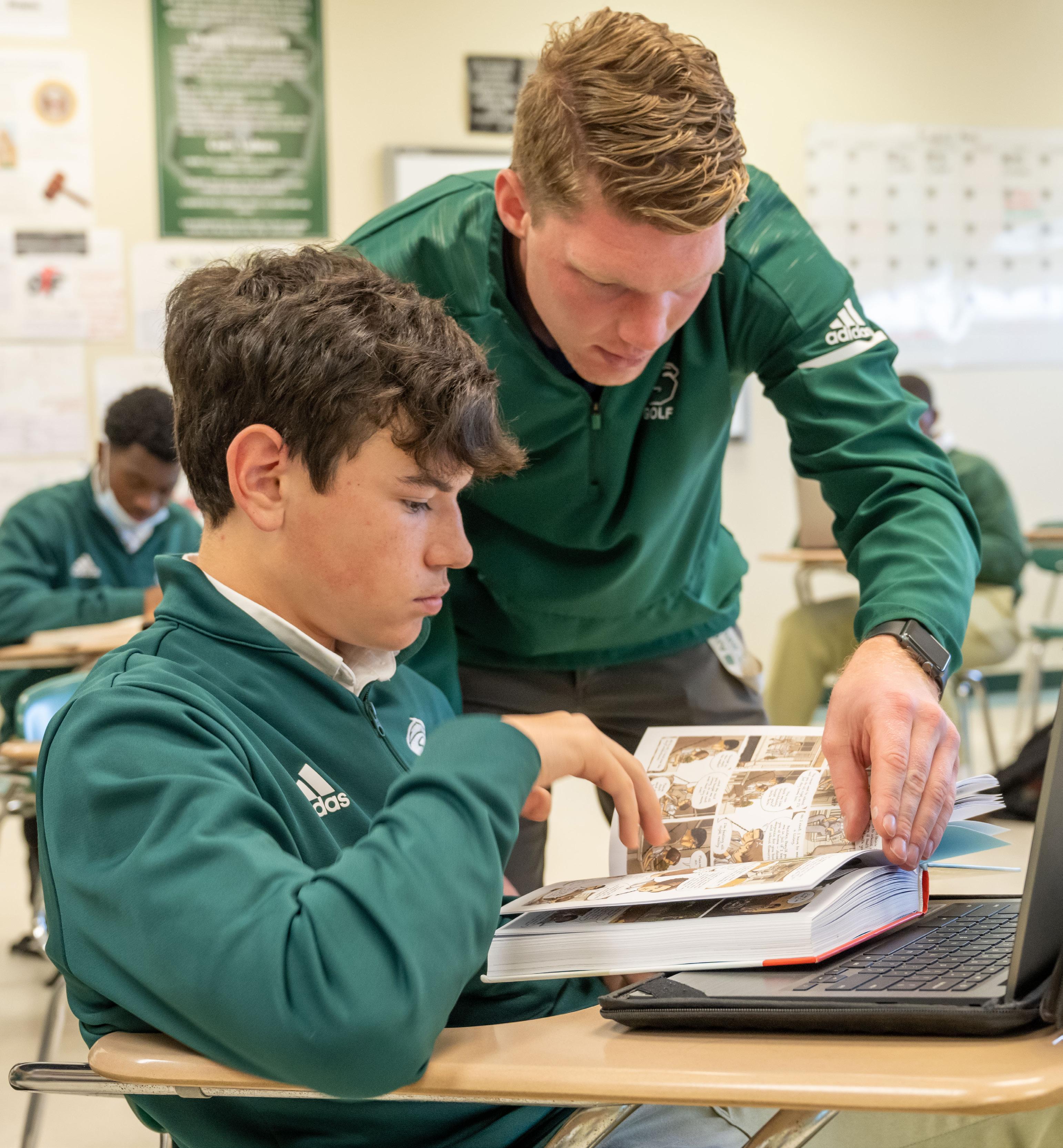
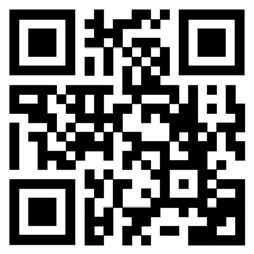

J. D. VANCE: HILLBILLY FOR CONGRESS
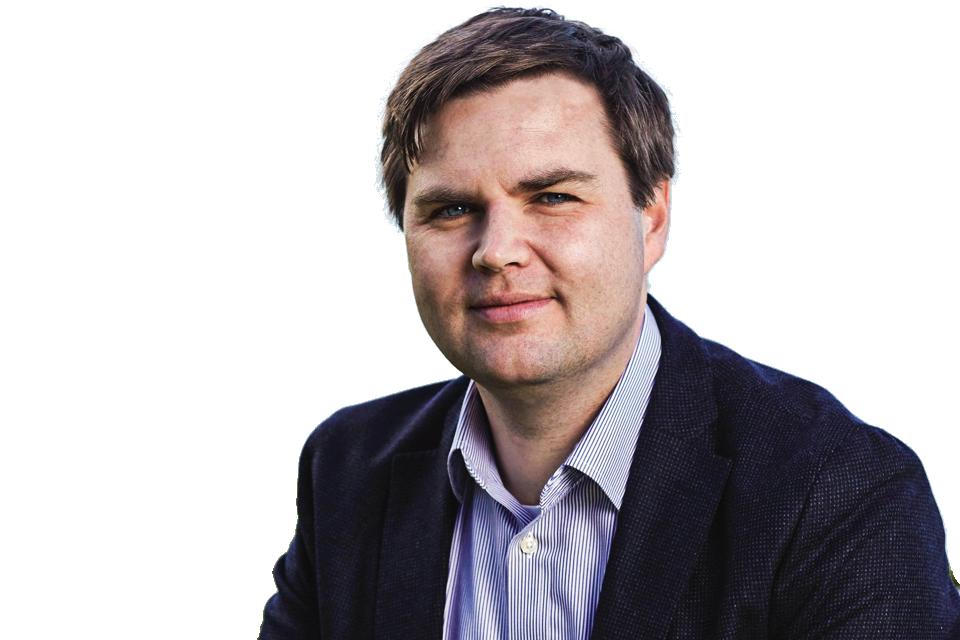 Author: James David Vance
Author: James David Vance
LET’S GO TO A CONCERT
of subjects who then attended a concert. After the first 20 minutes of the gig, they found that the subjects already had a 25% increase in feel ings of happiness, self-worth and community,

world halted. For almost two years, live music was extinct, and it was during this time that I came to realize how desolate the world felt due to the void in music and the lack of communal
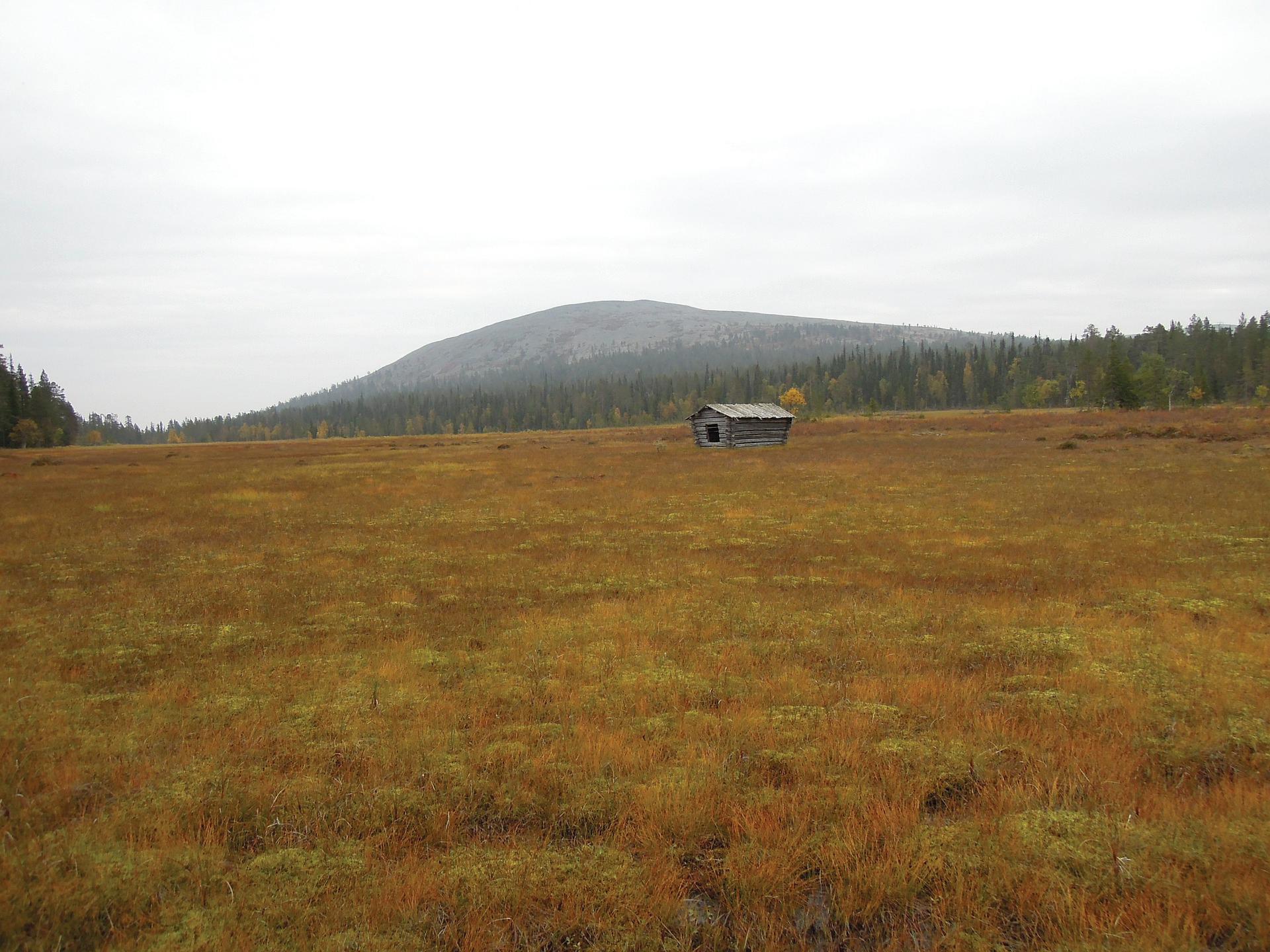
is nothing guaranteed in this world other than the power and pleasures of music.
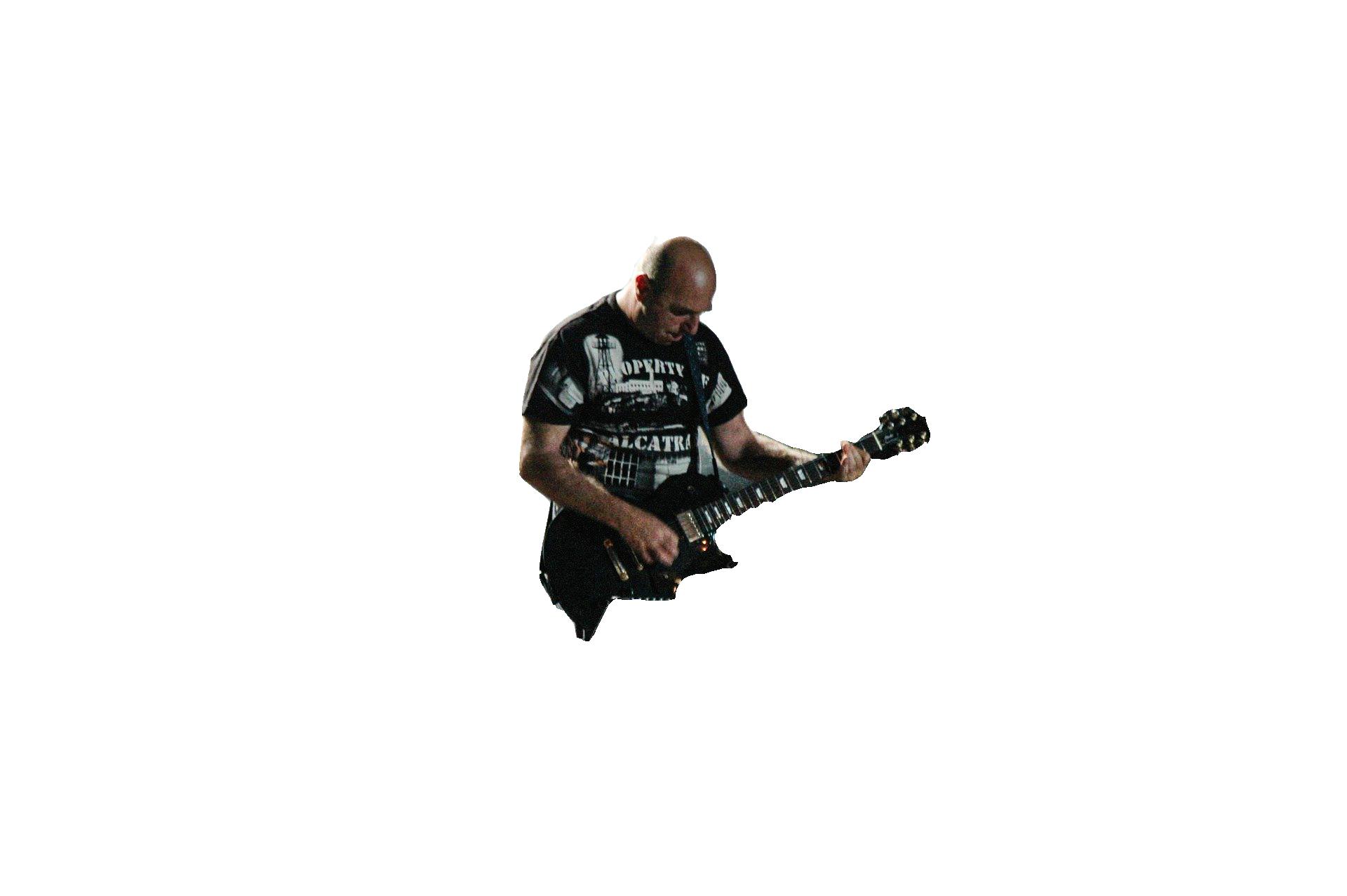
“Hillbilly Elegy: A Memoir of a Family and Culture in Crisis”
If you like: Autobiography, memoir, non-fictionBy GABRIEL ZARAZUA scene Writer
“
b efore I started painting, I thought painting was a magic that only a selected few could use.”
Art: one of the most beautiful things that we were given on this earth. As it evolved over time, we have come to see art in many different forms and expressions. h owever, there’s this strange notion behind it. That the only people who cre ate art are chosen, those gifted with talents and nothing more. Like everything else in life, art is something that requires hard work, with talent only taking you so far. That is what Yatora Yaguchi learns in “ b lue Period.”
“ b lue Period,” based on the manga by Tsubasa Yamaguchi, directed by Koji m asunari and Katsuya Asano, follows Yatora Yaguchi. Yaguchi is an excellent high school student, but deals with the feeling of emptiness in his life. It is not until he sees a painting at his school’s art club that he pursues the visual arts, deciding to try (and get accepted) into the Tokyo University of the Arts (TUA) after he graduates.
b eing an art major myself, I can say that this show is one the best depictions of showing the life of an artist, and some of their uprisings as well. At the beginning of the show Yaguchi is a prime example of what most people assume the life of
an artist would be like. When seeing a painting, he raves about how he envies someone that was born with such talent. While artists understand that people are trying to compliment them, it is important to acknowledge that talent only took them so far. To create something artists can be proud of, requires hours of practice and dedica tion, something that Yaguchi finds out quickly when he has a change of heart and decides to pur sue art himself.
“ b lue Period” also does a great job of depict ing the harsh realities of being an artist. o ne of the biggest challenges Yaguchi faces is telling his parents how he wants to pursue art in college. n ow thankfully, my parents were supportive in my pursuits of being an art major; however, there are plenty of people that I have met who struggle with having any kind of support in their path of becoming an artist. We hear the same questions of concern all the time. “ h ow will you make mon ey?” “What kind of work will you find?” “Will any one buy your art?” b elieve me, we are aware of the concerns, but we do it because it’s our passion and that is what this show exemplifies.
When watching “ b lue Period” as an artist, I can say with confidence that the show educates the audience, along with the main character, the var ious artistic techniques. With the author of the manga graduating from art school herself, she

made sure to make this story as accurate as pos sible. m aking sure each technique is right, while also showing the struggles many artists face try ing to consistently create great pieces of work. The only critique I have of this show is that the pacing is too fast, as they skipped out on a lot of Yaguchi’s development of an artist compared to the manga. I would assume it was so they could fit the first part of the story in 12 episodes.
Art, while not math or science, is still physically and mentally demanding. It is not something that can be rushed or learned quickly. It requires pa tience, practice, strong will and the motivation to create something beautiful. Artists go through the same struggles as Yaguchi, but we all do it be cause it’s something we love. And, at the end, be ing able to see something we created makes all the hard work worth while.
Contact Gabriel Zarazua at gzarazua@nd.edu“Blue Period”
Directors: Koi Masunari, Katsuya Sano
Starring: Johnny Yong Bosch
Where to Watch: Netflix
By MAGGIE CLARK s cene WriterAs we enter autumn, TikTok has taken a turn from focusing on the “coastal grandmother” sum mer aesthetic, to one more fitting of the current season: “ m eg r yan Fall.” This trend is inspired by the namesake’s hit movies of the 80s and 90s. b ecause of the popularity of the aesthetic, many of r yan’s movies have faced a resurgence in pop ularity. Among her most well-known works is the iconic “When h arry m et s ally...,” a 1989 roman tic comedy written by n ora e phron. In this film, r yan’s character decorates herself in warm col ors, tweed jackets, baggy jeans and thick sweat ers: all essentials of the TikTok aesthetic. e ven greater than r yan’s outfits in the film are the memorable story and its characters.
“When h arry m et s ally...” stars b illy c rystal and, of course, m eg r yan. The film follows the friendship of h arry b urns, a stubborn man who believes in the impossibility of friendship be tween men and women, and s ally Albright, a
determined, confident woman who tends to have a more optimistic point of view. d espite having different approaches to the world, the two char acters share in their growing disillusionment with dating in new York c ity, and find friendship with each other through it.
o verall, “When h arry met s ally...” is an extremely funny and even more so heartwarming story. The main reason as to why the movie is so great is the performances of the actors. The chemistry between c rystal and r yan is succinct and memorable, but each actor also creates a character that exists won derfully on their own. Additionally, supporting ac tors c arrie Fisher and b runo Kirby are fantastic in the film, making a just as intriguing secondary plot line. These memorable performances can be attrib uted to not only the talent of the actors, but also the comedic genius found in nora e phron’s writing.
Apart from the memorable acting and script, the general atmosphere of “When h arry m et s ally...” is another reason why the movie is so enjoyable. The film takes place in n ew York c ity and follows h arry and s ally through the changing seasons.
Through this, viewers get to see a beautiful fall (contributing even more to the TikTok aesthetic) and a cozy c hristmas in n ew York. The film acts as a love letter to not only love itself, but also to the city of n ew York, as shown through both the main plot, and the short clips of unnamed elderly couples discussing their love stories in serted throughout the film. It is because of n ew York that all of the characters of the story are able to experience love, as reflected through the ro manticized ambience of the city. To add on, the soundtrack created by h arry c onnick Jr. adds even more depth to the already romantic and gor geous atmosphere created by e phron’s script, the actors’ performances, and the setting.
All in all, “When h arry m et s ally...” is a phenom enal movie that can be enjoyed in any season, but is definitely a must-watch in order to truly appre ciate not only the “ m eg r yan Fall” aesthetic, but also the value found in time, in friendship and in love.

Happy Birthday: Spread some joy. kindness and consideration will help you charm your way into opportunities galore this year. follow through with a disciplined attitude and some concrete ideas to share with the people you want to work alongside, and you’ll accomplish plenty. your personal gain will buy you the freedom to make improvements at home and to the relationships that matter. love is favored. your numbers are 6, 11, 23, 28, 31, 34, 42.
ARIES (March 21-April 19): Surround yourself with intelligent and helpful people. Team up and see how much you can accomplish. Don’t let anger set in if someone disagrees. Be a good listener, but in the end, do what works best for you.
TAURUS (April 20-May 20): If you don’t reveal your opinions, you’ll gather information that can help you decide what is best and who is best for you to work alongside. Put your energy into something that matters to you, and you’ll make a difference.
GEMINI (May 21-June 20): Mingle with people who are excited about reaching similar goals. Put your heads together, and you’ll save time. Take an aggressive position in any group you join. Be a leader, not a follower. romance is encouraged.
CANCER (June 21-July 22): keep your life doable. Indulgence will hold you back. focus on your dream, and use what you must work with to get where you want to go. Don’t borrow from others or agree to something you don’t want to pursue.
LEO (July 23-Aug. 22): Think twice before you make a move. The suggestions made will be better for the person offering advice than for you. Do your due diligence and do what’s feasible. know your audience, your goal and how to get what you want.
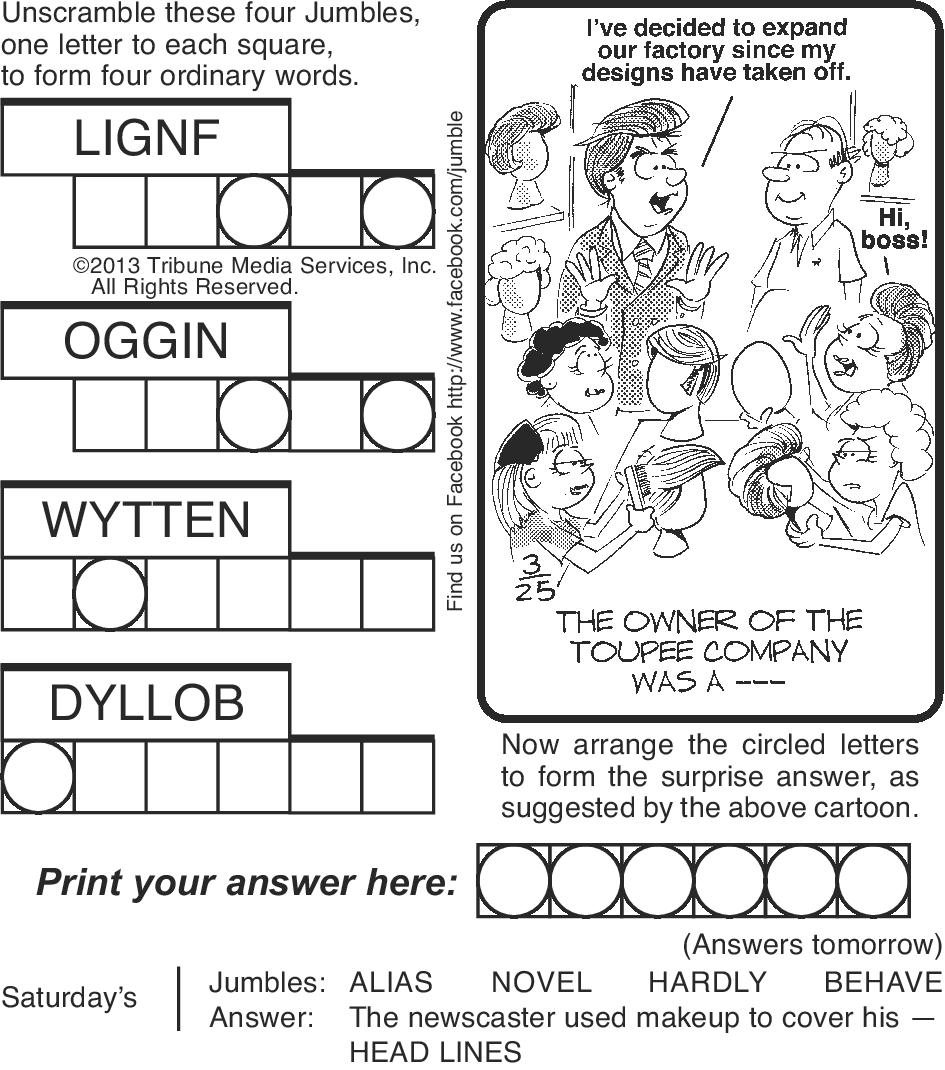
VIRGO (Aug. 23-Sept. 22): get involved in something that can open doors. Make new connections, get involved in something that interests you and learn something new. A steady pace, lots of talks and partnering with someone as eager as you will pay off.

LIBRA (Sept. 23-Oct. 22): A simple change can make a difference in how you live and work. look at the variables and consider what you can do to tweak your plans to ensure everything runs smoothly. look for alternatives, and everything will fall into place.
SCORPIO (Oct. 23-Nov. 21): Mix and mingle, discuss concerns, incorporate a schedule and don’t second-guess your next move. Embrace life, turn your living space into your castle and entertain people who make you think. Don’t be afraid of change.
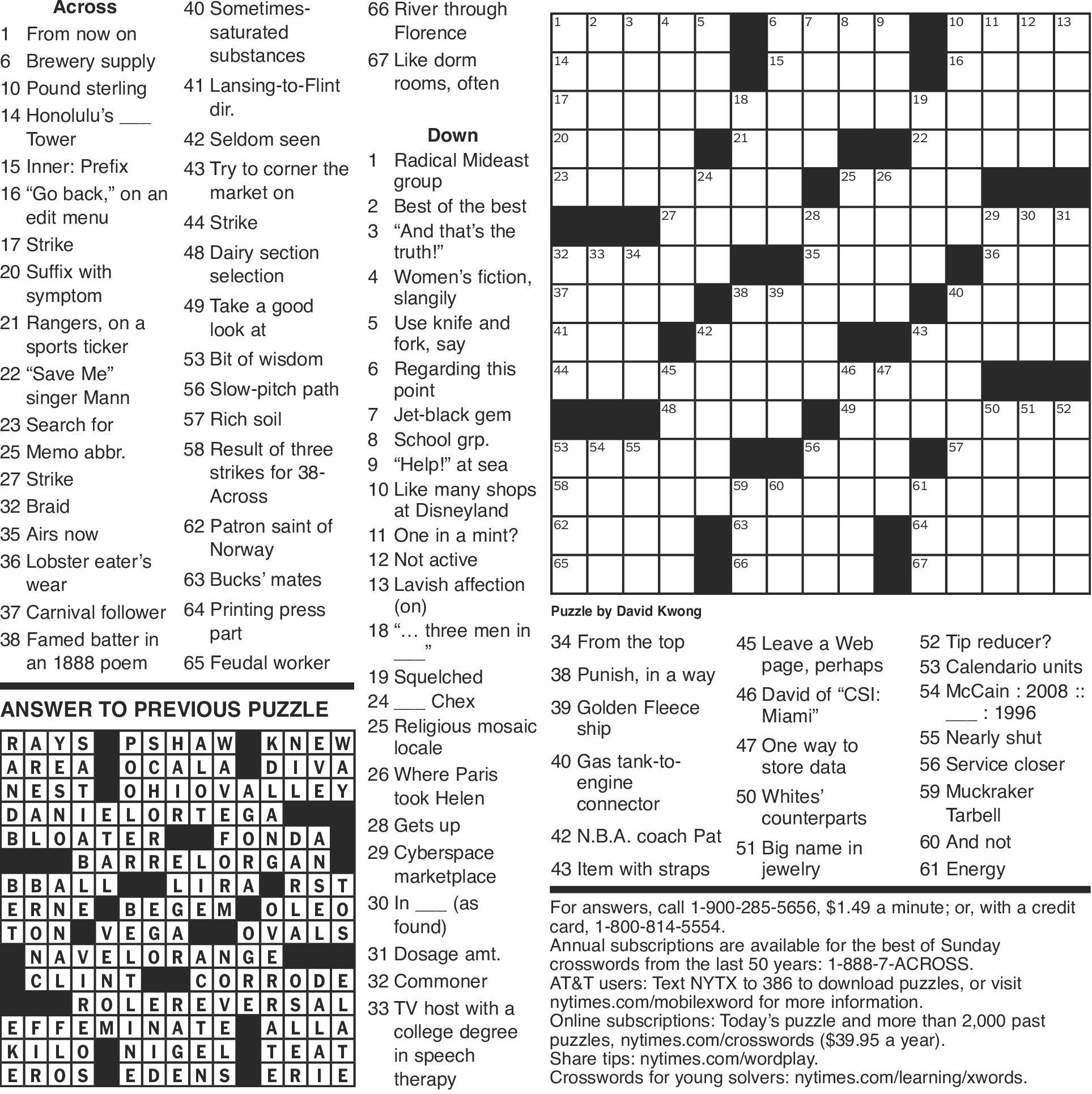
SAGITTARIUS (Nov. 22-Dec. 21): Concentrate on financial gains. Do something nice for someone you want to impress. Share your long-term plans, and put a timeline in place to help get things moving in a direction that improves your life. Be receptive to new beginnings.
CAPRICORN (Dec. 22-Jan. 19): keep your emotions out of matters concerning work or finances. Be reasonable regarding purchases and what you are willing to take on to get ahead. A change is necessary but must be worthwhile. Do only what’s essential.
AQUARIUS (Jan. 20-Feb. 18): Invest time and money in yourself. update your look and the way you do things. Incorporate better technology or the latest gadget geared toward giving you the edge you need to surpass any competition you encounter. Contracts are looking good.
PISCES (Feb. 19-March 20): keep your thoughts and opinions to yourself, and you’ll avoid an argument with someone who doesn’t share your sentiments. Put your energy into your home, family and romancing someone you deem special. A partnership and shared expenses will give you greater financial freedom. Birthday Baby: you are charismatic, engaging and wise. you are focused and ambitious.
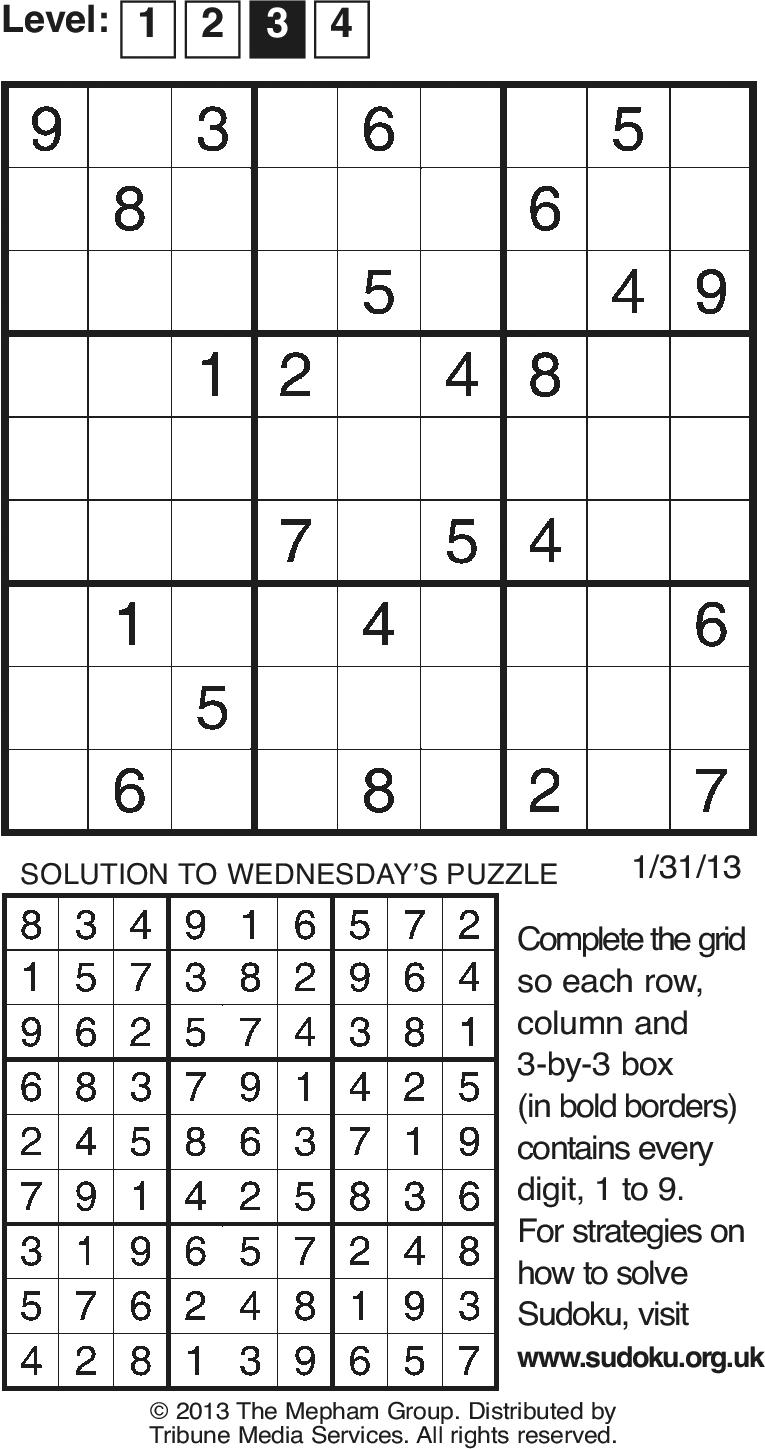
Irish look to continue streak
By ADAM AKAN sports WriterWith selection day for the nc AA m en’s s occer c hampionship only six weeks away, the n otre d ame Fighting Irish have their work cut out for them to prove to the committee they deserve to be one of the 48 teams selected. An o ctober sched ule loaded with competitive Acc match-ups should give the Irish the opportunity to do just that. n otre d ame will begin their gauntlet of a month tomorrow night in b loomington against the Indiana University h oosiers.
The Irish enter this game with a 5-3-1 overall record, carrying a two game win ning streak. n otre d ame’s last victory came Friday night against b oston c ollege at Alumni s tadium. Junior goalkeeper b ryan d owd, as well as the efforts of several freshmen, helped snag the Irish a hard fought victory.
While the Irish did find some bright spots in the match, they had nearly even possession and shots on tar get to a sub-.500 team. They will need to be more disci plined and decisive against the h oosiers Wednesday.
The h oosiers, despite be ing a historically dominant men’s soccer program, enter this match with a mere 4-23 record. They carry some questionable results, in cluding a 3-3 tie at home to Portland and a draw at home to m ichigan s tate, a team the Irish defeated 3-2 on the road. They also stumbled to a 2-2 draw in Ann Arbor against the Wolverines.
h owever, the h oosiers do have some results that show case their team’s talent and depth—including a 2-1 win over b utler, a 2-0 defeat of n o. 20 Akron and a 4-1 rout of n orthwestern. They also gave a then n o. 1 (now n o. 23) c lemson all they could handle on the road, barely falling at a score of 3-2. They
suffered another close loss in c olumbus against a strong o hio s tate team, ranked 17th in the nation, only losing 2-1.
b esides their intense bat tle with Acc behemoth n o. 7 s yracuse in n ew York, a game that ended with a gutwrenching 1-0 loss for the Irish, this match may be their biggest test yet. With crucial Acc matches throughout the month and the tournament just on the horizon, now is the time for the Irish to find their best form.
They will need to soon in order to compete with sides such as n o. 11 Louisville, n o. 2 d uke and n o. 25 Pittsburgh before the n ov. 14 s election s how. Wednesday’s match against IU will serve as a litmus test for this team’s progression.
h ead coach c had r iley is aware of the challenges ahead, and what his team must do to continue to stack victories in a schedule where “every game is a fight”.
r iley said he urges his team to “trust the prepara tion that has led them up to this point” as well as “to fo cus on managing their time and minutes in training as much as they can.”
r iley was adamant that the team’s number one priority should always be to be “ready for games” as the “loaded schedule” begins to take a mental and physical toll on his side.
IU may not be an Acc op ponent, but at this stage of the season, they are one of the most crucial games the Irish have left. They will need to give it all they have and continue their stretches of excellence from the past two games in order to defeat this historic program.
n otre d ame will take the field at b ill Armstrong s tadium at 7 p.m. ed T and will be streamed on the b ig Ten n etwork.
Contact Adan Akan at aakan@nd.edu
College football top games week 6
Joseph Tunney sports Writer5. texas @ oklahoma, 12:00 p.m., ABC, ( texas -7)
s andwiched in between the two weeks of the Texas s tate fair in d allas is the r ed r iver s howdown between Texas and o klahoma. The game is almost guaranteed to be a good one as regardless of the quality of the teams, only one game since 2014 has been decided by over ten points. o klahoma has had a rough past two weeks, los ing to both Kansas s tate and T c U after rising as high as sixth in the rankings. head coach b rent venables, who is seen as a defensive whisper er, needs to work some mag ic to get this s ooners defense back to the level o klahoma fans expected. Texas also could welcome back quar terback Quinn e wers, who hasn’t played since getting injured versus Alabama in the second week of the sea son. The Longhorns fell victim to an upset bid from Texas Tech two weeks later, but rebounded with an 18 point win over West v irginia to get to 3-2. b oth fan bases are some of the most de voted in college football, and whichever head coach loses this game will get a lot of heat. c an o klahoma stop their slide? o r, will Texas re assert themselves as a con tender in the b ig 12?
No. 8 tennessee @ No. 25 LSu, 12:00 p.m., ESpN ( tennessee -2.5)
After losing to Florida s tate in heartbreaking fashion in week 1, head coach b rian Kelly and the L s U Tigers have won four straight games to sneak into the bottom of the top 25. In their sec vic tories, the Tigers have come back from 13 points against m ississippi s tate, and a 17 point deficit against Auburn. Quarterback Jayden d aniels has carried L s U at times, leading them on pivotal drives to help regain leads. The defense has also made plays, forcing key turnovers. The next game is clearly the toughest on L s U’s schedule so far. Tennessee has earned a pair of big wins against Pitt and Florida, allowing them to skyrocket into the top 10. Quarterback hendon hooker has been a playmaker for the volunteers, averaging nearly 300 yards passing per game. The volunteers also have the benefit of coming off of bye, allowing them to prepare for the mobility
and improvisational skills of d aniels. Wide weceiver c edric Tillman, one of the best pieces for Tennessee, is questionable to play. Getting him on the field would be a huge boost for Tennessee as they go on the road to one of the toughest places to play in college football
3. No. 16 Byu @ Notre Dame, 7:30 p.m., NBC, (Notre Dame -4)
b YU has shown flashes of brilliance this season while also dealing with some in consistent play. After win ning their first game easily, they took b aylor down to the wire, losing in double over time. They then got blown out by o regon, but have responded with two wins over inferior competition in Wyoming and Utah s tate.
Although the c ougars won, in each game they have failed to put together four quarters worth of quality football. If they want to beat notre d ame, and keep the goals they have for this sea son alive, they can’t sleep walk at the start of the game.
They do have the benefit of quarterback Jaren h all, one of the most exciting players to watch in college football. notre d ame’s back seven will have to step up to the chal lenge against another prolif ic passing offense. The Irish have largely looked good against the pass, allowing just 21 points to o hio s tate and playing well enough ver sus north c arolina to put the game out of reach. There are still offensive questions, al though some have been put to bed for the time being af ter a 45 point performance against north c arolina. Furthermore, the Irish are coming off of a bye week, al lowing for more practice op portunities and a chance to get healthy.
2. No. 11 uCLA @ No. 18 utah, 3:30 p.m., FoX, ( utah -4)
Uc LA, led by quarter back d orian Thompsonr obinson, just knocked off a previously unbeaten Washington team last week. It was the b ruins’ first win over a top-15 team since 2014, and a statement win for head coach c hip Kelly. Thompson-r obinson’s skills as a mobile quarterback in addition to running back Zach c harbonnet has helped make the Uc LA backfield dy namic and fun to watch. The offensive line has more than held its own through the first five games. Although
Uc LA only won by eight, Washington never threat ened; their fourth quarter rally was only good enough to make the box score look bet ter. After Utah’s 3 point loss at Florida to begin the year, the Utes have responded with four blowout wins, the most impressive being a 4216 win over o regon s tate last week. Quarterback c ameron r ising is also a skillful run ner and passer with a lot of weapons surrounding him. s ophomore c lark Phillips III caught three b eaver passes for interceptions. Their de fense has looked much im proved, and they will need all of it to stop Uc LA. This is a game that could be a de ciding factor in the quest for a conference championship berth.
1. No. 17 tCu @ No. 19 Kansas, 12:00 p.m., FS1, ( tCu -6)
If someone told me that I would be ranking T c UKansas as the number 1 game this week at the begin ning of the season, I would have said that I have a bet ter chance of being struck by lightning. n evertheless, this game is an undefeat ed top 25 showdown with c ollege Gameday in town. Kansas has been the feelgood story of college foot ball. The Jayhawks are 5-0 for the first time since 2009. h ead coach Lance Leipold has been the architect of a masterful turnaround. Quarterback Jalon d aniels looked like a dominant play er in the first four games of the season, although he was bottled up against Iowa s tate. Kansas still found a way to beat Iowa s tate thanks to one of their best defensive performances in years. T c U has been led by its overwhelming offensive attack on the way to aver aging over 40 points in its first four games, all of them wins. They are ranked in the top 25 for the first time since 2019. Quarterback m ax d uggan threw for over 400 yards and five touchdowns in a romp over o klahoma, leading to him being named the Walter c amp n ational Player of the Week. This is the first time Kansas has hosted c ollege Gameday, but T c U is 6-1 during these high-level games.
Contact Joseph Tunney at jtunney@nd.eduThe views expressed in this Sports Authority are those of the author and not necessarily those of The Observer.
season.
The last player mentioned by Jackson was sophomore Jake b oltmann, who was one of only six Irish play ers to play in 40 games last season.
The talented roster has ensured that there will be a deep bench for the Irish, and according to Jackson, it might lead to some competition.
“There’s going to be a fight for playing time back there because we actually have nine defensemen, and I think pretty much all of them can play.”
Production Replacement
d iving into the numbers from last season, the Irish have much to replace from last year’s teams. The play ers who graduated from nd last year accounted for 35.2% (45) of the goals scored by the team. The same was true for assists; the Irish have lost 34.2% (79) assists from last sea son’s roster. That adds to a loss of 3.34 points per game, a dramatic production loss.
The Irish also lost a lot of clutch play after gradu ation. o f the 28 game-win ning goals the Irish had last season, the seniors scored nine.
The Irish losses will also impact the special team’s play. Last year’s class ac counted for 28% of the Irish power-play goals. That is not great for a team that ranked 31st in the power play last season with a 19.1% con version rate. s hort-handed goals took the biggest hit of all; the Irish are return ing a total of 0 short-handed goals from last season.
Where will the replace ment production come from?
m aybe grad transfers b en b rinkman, Jackson Pierson and c hayse Priemau. Add in d rew b avaro for good measure.
Pierson, Primeau and b avaro contributed powerplay goals on their teams last year, and could eas ily see some minutes on the power-play unity. And
Pierson and b avaro both had short-handed goals last season, showing they can spend some time on the kill.
c ombining the stats of the four transfer students, they had 31 combined goals and 51 assists for a total of 82 points. That totals out to 2.45 points per game, which is not the 3.34 points per game lost, but it certainly gets the Irish closer.
b eyond the general in creases in productiv ity that one would expect from classes progressing, junior forward Landon s laggert, preseason firstteam all b igTen, and n ick Leivermann should be two major forces for the Irish.
Where the Irish fall
In a b ig Ten pre-season c oaches poll, the favorite to win the conference were the m innesota Golden Gophers, with n otre d ame finishing in second. m innesota is an incredibly talented hockey team with national cham pionship potential. The Golden Gophers were just one of five teams to earn votes in U scho pre-season rankings and finished sec ond overall, just behind the d enver Pioneers. While not a certainty, it feels incred ibly likely that m innesota should win the conference regular season title.
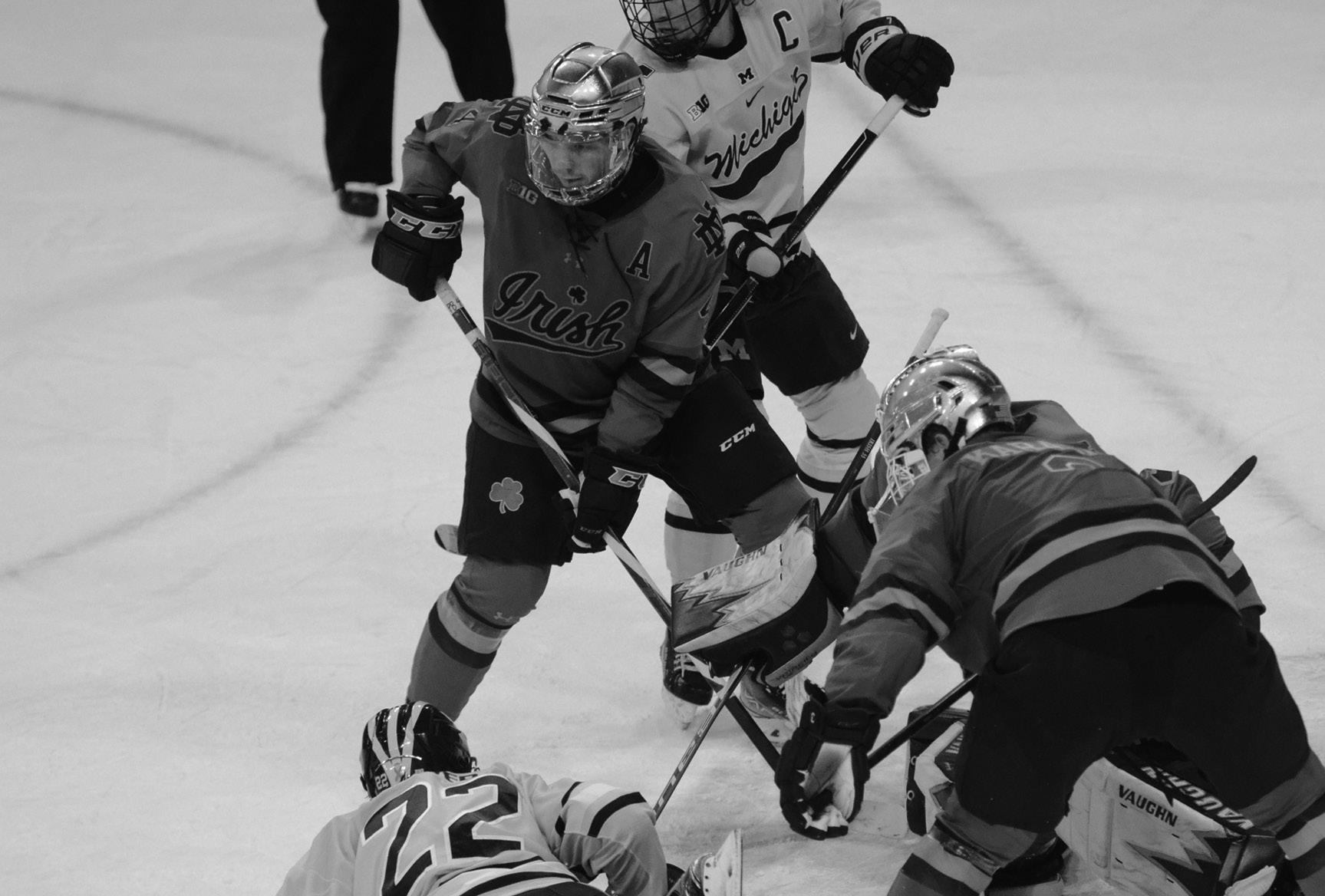
b ehind them should be m ichigan. m ichigan was number one overall team last season, and while they did not win the title, the Wolverines are bringing back a solid team that can compete with m innesota, but should finish in second place.
n otre d ame has the po tential to break into the top two, but it seems more likely that the Irish will finish in third.
o hio s tate, who finished just five points behind n otre d ame in the standings last year, should continue to be a tough competitor. The b uckeyes should be step for step with the Irish com peting for third behind the goaltending of Jakub d obes.
Contact Tom Zwiller at tzwiller@nd.edu
Leivermann
of those skilled players too much time and space, that’s going to come and bite you,” Leivermann said.
Leivermann stressed the im portance of taking less penalties in the future, and he knows that his team will improve on the pen alty kill as the year goes on.
“The number one goal is obvi ously not to take penalties at all, and that’s going to benefit us a lot,” Leivermann said. “[head] coach [Jeff Jackson] has always been really dialed in on the pen alty kill and that’s why we had the best PK in the country last year. so, it’s just taking some tidbits of what we did last year, but you also have to change things because we have new personnel on the backhand.”
Leivermann is the sole captain on the team this year, and he has enjoyed being a mentor to his younger teammates.
“being a fifth year, you are a little bit older, and it has been fun taking in some of those younger guys like [freshman defense man michael] mastrodomenico and [freshman forward] fin Williams. They’re really good kids,” Leivermann said. “It’s obvi ously not just me; our leadership stems from our juniors, seniors and four or five grads, and every one of those guys can be a leader and a captain on the team.”
mastrodomenico and Williams are joined by two other freshmen in forward niko Jovanovic and goaltender Jack Williams, and Leivermann feels like all four have made great strides so far.
“It’s obviously a little bit diffi cult being a freshman in college hockey, but they’re finding their
way and I think all four have im proved on a day-to-day basis,” Leivermann said.
Jackson is confident in Leivermann and the rest of the leaders on his team ahead of the season.
“I like our leadership group.” Jackson said, “There was some adversity coming into today’s game. for the most part, I thought we handled it pretty well. I have to rely on them in the locker room because I am not always in there.”
Leivermann believes the Irish have grown significantly as a team since the summer.
“We have grown quite a bit,” Leivermann said. “We have ob viously been together now since early June. Just as a group, we are really tight knit and we have really good leadership.”
Contact Nate Moller at nmoller2@nd.edueven when they fail to take care of the ball. b ut they could be in trouble later in the season if they lose the turnover battle against an elite opponent.
Texas A&M and Oklahoma stumble again e very year, we see teams with sky-high preseason ex pectations fail to live up to the hype. Last season, Iowa s tate and n orth c arolina were ranked n o. 7 and n o. 10, respectively in the pre season AP Poll before fin ishing with records of 7-6 and 6-7. In 2020 preseason polls, n o. 6 L s U and n o. 7 Penn s tate both failed to post winning records. These teams pop up ev ery year to serve as a stark reminder that no one can really predict how a season will turn out and 2022 has been no exception. n otre d ame began the season ranked n o. 5, but a shock ing 0-2 start dropped them out of the rankings entirely.
After Week 5, it looks like the Irish might have company, as preseason top-ten teams Texas A& m and o klahoma each suf fered their second loss of the season in blowout fashion.
Texas A& m ’s playoff chances took a dent in week two when they were up set by Appalachian s tate. The back-to-back wins against ranked opponents m iami and Arkansas that followed, though, gave the Aggies hope that they could get back in the hunt. Those hopes have now been erased, as they were defeat ed decisively on the road against m ississippi s tate, 42-24. Texas A& m ’s defense, their calling card earlier in the season, had no answer for the b ulldogs’ dynamic passing attack. Quarterback Will r ogers continued his excellent start to the sea son by posting 329 yards and three touchdowns. The Aggies could still theoreti cally win the sec West, but it is difficult to imagine them beating Alabama this week.
d espite losing their head coach, quarterback and sev eral other key players and recruits, o klahoma breezed to a 3-0 record in non-con ference play and looked impressive while doing so. e verything came crashing down when b ig 12 play be gan, and the s ooners’ con ference slate started with consecutive losses against Kansas s tate and T c U. The T c U loss on s aturday was particularly backbreak ing for a team coached by b rent venables, a renowned defensive specialist; the h orned f rogs scored 41 points in the first half alone en route to a 31-point win, 55-24.
Texas A& m and o klahoma still have time to right the ship and avoid the igno minious finishes that the teams mentioned earlier experienced, but it is not a good sign that their pre season goals are already out of reach less than halfway through the season.
Irish face off against Wolfpack, look to stay in playoff contention
b oston c ollege. n otre d ame dominated b oston c ollege last week, winning three to nothing and leading the e agles sixteen to seven in shots and six to two in cor ner kicks. Junior midfielder e va Gaetino returned to play against bc after exiting early with a head injury in the game against Pitt.
n ow 2-2 in the A cc , the Irish are looking to domi nate in their next six games leading up to the A cc tour nament at the end of the month.
A cc , three spots behind the 6th-ranked Irish.
n otre d ame averages 2.36 goals per game compared to nc s tate’s 1.38. n otre d ame also only gives up an aver age of .73 goals per game, while nc s tate gives up an average of 1.23.
By SAMMIE McCARTHY sports Writern otre d ame women’s soccer hosts nc s tate this
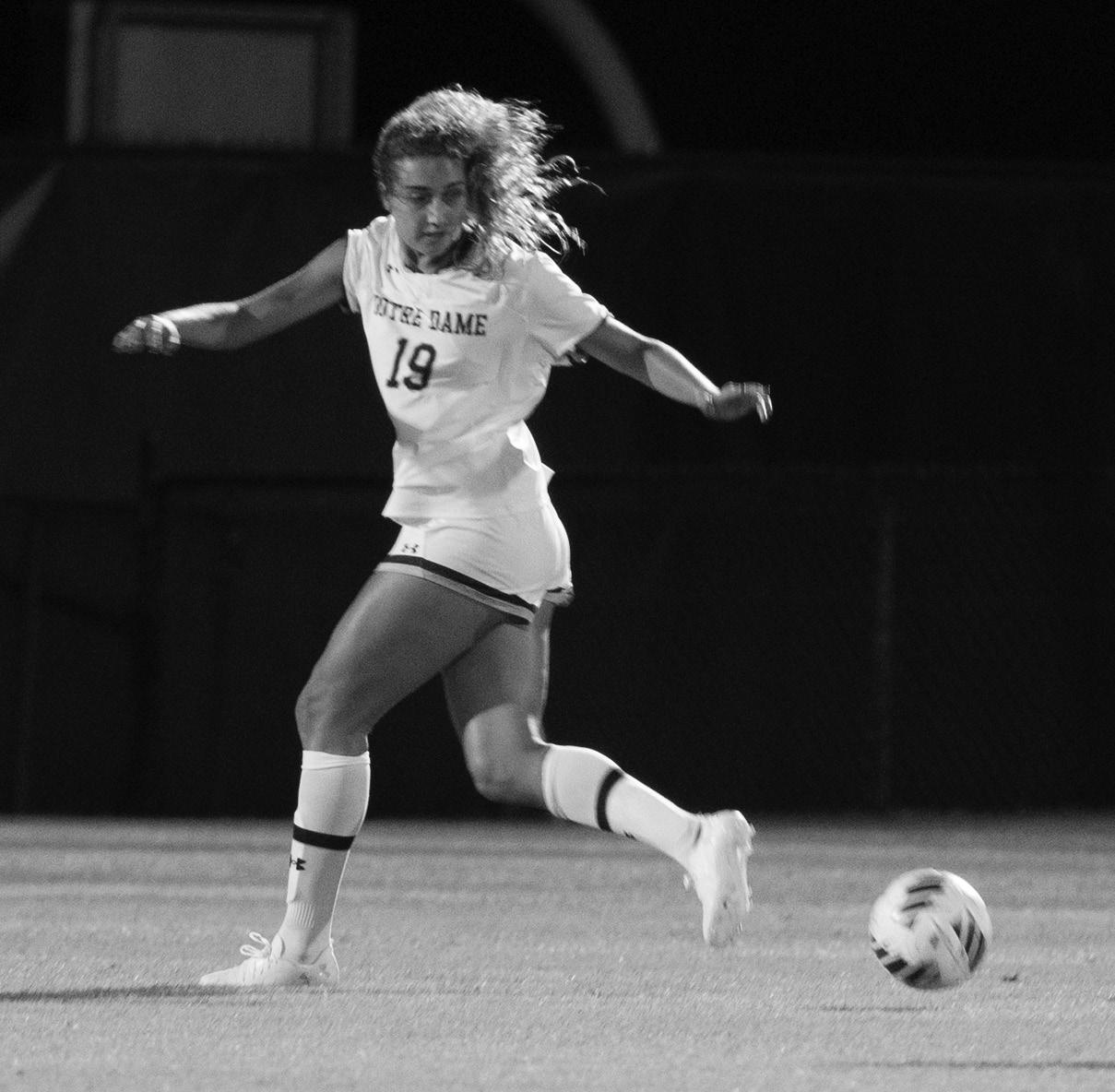
Thursday in their fifth con ference game of the season. The sixteenth-ranked Irish take on the Wolfpack one week after a win against
The game against nc s tate will test n otre d ame’s abil ity to perform consistently against A cc competition. The Irish have had trouble performing consistently in A cc play so far, alternating wins and loses across their four conference games. The team hopes that last week’s strong performance against b oston c ollege will set the tone for the rest of confer ence play. nc s tate is cur rently ranked 9th in the
Also 2-2 in the A cc , the Wolfpack has had similar struggles with consistency as the Irish have. nc s tate recently suffered a crushing 6-0 loss against d uke, but rebounded last Thursday to beat c lemson, who beat n otre d ame 2-1 earlier in the season. Their performance against c lemson proves that the Wolfpack can’t be over looked. That being said, nc s tate has yet to beat a na tionally ranked team, going 0-1-2 against ranked op ponents. It seems nc s tate has been unable to deliver in tough games so far. This bodes well for the sixteenthranked Irish, especially on their home pitch.
At this point in the season,
both teams are competing to earn a spot in the A cc tour nament.. The top six teams in the A cc qualify for con ference playoffs. c urrently n otre d ame is sixth in the A cc , so from here on out every game is important for keeping the Irish in playoff contention. The Irish face two more nationally ranked opponents in their final six games of the regular sea son. Given this challenging schedule, the Irish will look to earn a win while they can.
nc s tate is currently ranked ninth, but the sixth through ninth-ranked teams all have the same A cc record. A few wins could easily put nc s tate in the running for the playoffs as well.
This match up kicks off on Thursday at 8 p.m. in Alumni s tadium. It will also be streamed on the A cc n etwork.
Contact Sammie McCarthy smccart9@nd.eduWeek 5 college football takeaways
By MATTHEW CROW s ports WriterThe cost of firing a head coach in today’s college football landscape is higher than ever. m assive buyout payments that come with the early termination of a contract means that schools pay millions of dollars just to get their coaches to leave.
After his exit in 2021, former L s U coach e d o rgeron re ceived a buyout of $17.1 mil lion. In a recent interview, o rgeron acknowledged the massive paycheck he re ceived, joking that his re sponse to losing his job was to ask, “What time do you want me to leave and what door do you want me out of, brother?”
With this huge amount of dead money being par for the course with coaching changes, schools do whatev er they can to make it work with their staff. In addition, they only fire their coach if they believe new leadership to be absolutely necessary.
A pair of programs that re cently parted ways with their head coaches received validation that their deci sion was correct by earning upset victories with interim coaches at the helm.
In 2018, longtime Georgia Tech head coach Paul Johnson announced his re tirement. For his replace ment, the school tabbed former Temple head coach Geoff c ollins, with the intention of replacing Johnson’s preferred triple option attack with a more conventional offensive scheme. Less than four full seasons later, the Yellow Jackets are back in the coaching market. c ollins’ firing was announced last week after three consecu tive three-win seasons and a 1-3 start to this year that did nothing to inspire con fidence of a turnaround in the near future. In their first game without c ollins, the Yellow Jackets went on the road and stunned n o. 24 Pitt.
The Panthers out gained Georgia Tech by almost 100 yards.
b ut, an opportunistic defense that forced three turnovers and 157 rushing yards from run ning back h assan h all were enough to scrape out a 26-21 upset victory.
n ebraska had been trying to recapture its 90s mag ic for nearly two decades when it hired s cott Frost as its new head coach in 2017. Frost, a former national
championship-winning h usker quarterback and a former national champi onship-winning U c F head coach, seemed like a per fect fit in every sense of the word. The pairing end ed up being anything but perfect; n ebraska, once a powerhouse, posted losing records in each of Frost’s four seasons and did not qualify for a single bowl. After years of speculation of his seat getting hot, a home loss to Georgia s outhern was the last straw and Frost was fired after a 1-2 start to the season.
In their first game with out Frost, n ebraska’s strug gles continued in a blowout loss against o klahoma, but the h uskers turned things around this week, end ing their nine-game losing streak against F bs oppo nents with a 35-21 win over a solid Indiana team. It remains to be seen how the rest of the season will play out for Georgia Tech and n ebraska, but the tra jectories for both teams’ seasons have improved sig nificantly since their mid season coaching changes. This week, another highprofile coach was let go when Wisconsin fired Paul
c hryst. The b adgers will look to continue the trend of teams improving their play without a permanent coach and they will have their first chance to do so against n orthwestern this weekend.
g eorgia needs late comeback to escape m issouri
d efending national cham pion Georgia’s seasonopening 49-3 domination of o regon (which now some how looks even more im pressive given how well the d ucks have played since) gave way to a litany of pre mature questions about the b ulldogs’ greatness. Is Georgia’s defense some how even better than last year’s unit, which was one of the greatest of all time? Will quarterback s tetson b ennett, who many expect ed to be benched last year, win the h eisman? c an any one beat Georgia (or even score a touchdown against them)?
After a sloppy 39-22 win over Kent s tate and a nailbiting 26-22 victory against m issouri, during which Georgia trailed by ten early in the fourth quarter, those questions can begin to be answered. n o, Georgia’s
defense is not better than last year’s, which allowed over twenty points just once (in the sec c hampionship against Alabama). n o, b ennett is probably not a h eisman contender after throwing for zero touch downs in the last two games combined. We still do not know if anyone can beat Georgia, but it certainly looks much more plausible now than it did after the o regon game.
The b ulldogs’ recent per formances could simply be a case of them overlooking a pair of weaker opponents, but they revealed a blueprint for how Georgia could be beaten. Georgia out-gained Kent s tate and m issouri by about 200 yards each, but their turnover margin was a combined -4. This allowed less talented teams to hang around with them, and in m issouri’s case, nearly de feat them. In Georgia’s first three games, all wins by over 30 points, the b ulldogs did not have a single turnover and recorded six takeaways. Their overwhelming talent has thus far given them a large enough margin for er ror to remain undefeated,
Gabe Perreault scores twice as NTDP tops Notre Dame men’s hockey team
By RYAN MURPHY sports WriterThe n o. 8/9 n otre d ame Fighting Irish men’s ice hockey team dropped its lone preseason scrimmage to U s A h ockey’s n ational Team d evelopment Program ( n T d P) under-18 team by a 5-3 score s unday night. In a high-paced, back-and-forth contest, the n T d P capital ized twice on five power play opportunities to earn an edge against the Irish.
c oming off of a 4-3 win on the road at m ichigan s tate on s aturday night, the n T d P squad found them selves on their heels early. Less than a minute into the opening frame, Irish senior forward Trevor Janicke be gan an offensive cycle in the right corner, circling and leaving the puck for new teammate Jackson Pierson, a graduate student trans fer from the University of n ew h ampshire. Pierson then circled in the corner himself and zipped a pass back to the right point for sophomore defenseman and e dina, m innesota, native Jake b oltmann. b oltmann expertly walked the blue line and fired a shot off of the stars-and-stripes deco rated pads of n T d P goal tender c arsen m ussen. The rebound came off the right pad quickly and right onto the stick of junior r yder r olston, who snapped the puck just between the right arm of the goalie and the post to give the Irish an ear ly 1-0 lead.
n otre d ame’s lead, though, was short-lived. After Irish defenseman c harlie b lackmun was giv en a 5-major penalty for a hit from behind, n otre d ame was forced to their first of 5 penalty kills this evening. In what would be a theme of the game for n otre d ame, the Irish penalty kill was stout until the very fi nal moments of b lackmun’s penalty but could not finish the kill. As the penalty was winding down, the n T d P’s Alex Weiermair made an er rant zone entry pass that teammate o liver m oore picked up off the half wall. The m innesota-committed m oore swooped in behind the goal and made a cen tering pass that was tipped onto the stick of Austin b urnevik in the slot, who snapped it past Irish senior goaltender r yan b ischel to tie the game.
The first-period scoring
was not done yet, though. b oth teams traded line rushes until n otre d ame struck gold on one of theirs. In a beautiful sequence, graduate student captain n ick Leivermann picked up the puck on his own blue line and spearheaded the attack. b acking up the n T d P defense, he hit the of fensive blue line and dished to sophomore forward Tyler c arpenter on the left flank, who rifled the puck again between the post and the right arm of m ussen to put n otre d ame up 2-1.
b ut with Leivermann in the box for an unwise and unnecessary interference penalty, n T d P was able to turn the tide late in the first. Just after the penal ty to Leivermann expired, b oston c ollege commit r yan Leonard rushed the puck in behind the n otre d ame net. h e absorbed a hard hit that sent him sail ing into the corner boards, but was nonetheless able to find Gabe Perreault with a pass. Perreault rounded the cage and tucked a wrap around inside the right post, sneaking it just barely past the outstretched pad of b ischel. With thirty sec onds remaining in the first, the n T d P had tied the game again.
The score remained tied after two periods as well, with each team adding goals in the second. o nce more, it was n otre d ame skat ing well to start the period. e arly on in the frame, the n T d P turned the puck over in the Irish zone, and n otre d ame’s h unter s trand and Jack Adams found them selves on a two-on-one from their own blue line. s trand carried the puck on the left, fed a flat pass to Adams on the right, who attempted the one-timer, but fanned on the puck.
That was not the end of the story, however, for Adams. As n otre d ame continued to carry the play, Adams found himself in another two-on-one, this time with sophomore Justin Janicke carrying the puck on his left. Adams, a 6’6 gradu ate student forward from b oxford, m assachusetts, did not miss the mark on his second opportunity. h e took the crisp pass from Janicke on his forehand, switched to his backhand, cut to the far post and shoveled the puck past the outstretched leg of m ussen to score.
With n otre d ame in the
lead 3-2, the n T d P would again level the game late in the period. After a n otre d ame powerplay during which the Irish could not manage a shot, and strug gled at times to gain the offensive blue line, the n T d P’s Leonard helped set up fellow bc commit Will vote to level the score. Leonard had just stepped out of the penalty box when he made a pass to the on rushing o liver m oore, who left a drop pass at the left face-off circle for v ote. vote snapped a shot that seemed to allude b ischel, beating him five-hole to bring the score to 3-3.
Then early in the third, the n T d P struck with the decisive game-winner. o nce more, it was Perreault who scored for the n T d P, and once more the goal came on the power play. With junior defender Zach Plucinski in the box for indirect con tact to the head of an n T d P player, another b oston c ollege commit, Will s mith, stepped in across the n otre d ame blue line on the right side of the zone. s mith fired a laser-beam cross-ice pass to Perreault at the faceoff circle, who beat b ischel high and to the glove side with an impressive snap shot. Perreault’s second goal gave the n T d P their first and only lead of the hockey game, in the game’s 41st minute.
That lead was all the n T d P would need to beat n otre d ame on this night at c ompton Family Ice Arena. There were times afterwards when it seemed like the Irish were going to throw everything and the kitchen sink at n T d P goal tender c arsen m ussen in or der to tie the game.
Indeed, the Irish attempt ed thirty shots in the third period. Twelve of those made it to goal, but most were blocked by n T d P skat ers. The n T d P defense stood strong late in the game and did well to keep the Irish on the peripheries of their zone, away from rebounds and loose pucks in front of the net.
r yan Leonard, who played well for the n T d P and had already garnered two as sists for his efforts, sealed the win for his team by scor ing an empty net goal with
just one second remaining in the game. When the final siren sounded at c ompton, the scoreboard showed 5-3 in favor of the visitors.
n otre d ame netminder r yan b ischel, who had a strong .916 save percent age in 16 games played last year for the Irish, finished tonight with 26 saves on 30 shots. o n the other end of the sheet, uncommitted goalie c arsen m ussen made 25 saves. The game’s leader in the stat column was cer tainly Gabriel Perreault, who displayed a good fin ish on his second goal and also led his team in shots on net. Perreault, whose father is former nh L vet eran Yanic Perreault, is also uncommitted.
The win continues the n T d P’s strong start to their season, as they are 6-0. The team will continue with their Kroger c ollege s eries at home next weekend as they host #20 m ichigan Tech on Friday and Lake s uperior s tate on s aturday. n otre d ame, meanwhile, heads to c olorado next weekend to get their regular season officially underway at the Ice b reaker tournament. The Irish take on the defend ing national champion and #1/1 d enver Pioneers in the opener on Friday at 9pm es T.
Future Prospects
o n a U sn T d P team lit tered with prospects, three Irish commits laced up the skates tonight for the national team. c arter s laggert, son of n otre d ame assistant coach Andy s laggert and brother to cur rent Irish forward Graham and former Irish forward Landon, roused a nice ova tion from the crowd tonight when he was introduced with the n T d P starting lineup.
m eanwhile, m aple Grove, m innesota, native d anny n elson centered the second line with m innesota com mit o liver m oore and s t. c loud s tate commit Austin b urnevik. n elson is one of the tallest and heaviest skaters on the n T d P roster, weighing in at 6’3, 203lb.
r iver Forest, Illinois, na tive Paul Fischer, a third n otre d ame pledge, blocked two shots while playing top pair minutes on defense for
the n T d P.
Discipline the Key n otre d ame head coach Jeff Jackson was quick to point out in his post-game press conference that n otre d ame struggled tonight to stay out of the penalty box. o n a night where the Irish were penalized 5 times, Jackson noted that the Irish are “not going to win games taking that many penalties.”
Twice n T d P victimized the n otre d ame penalty kill, and they scored short ly after another powerplay ended.
Denver looms
The Irish begin their reg ular season Friday with not just any game, but a game against the defending na tional champions. d enver scrimmaged against the University of n evada Las v egas (U n Lv ) club hockey team on s aturday night and won big, 10-0. The Pioneers got goals from seven differ ent scorers and a hat trick from sophomore c arter King. Although d enver will be without seven players who signed professional hockey contracts at the end of last season, they re turn 237 points, good for 5th in the nation in that department. The Pioneers will also be bolstered by h arvard transfer c asey d ornbach and m innesota transfer Tristan b roz.
When asked about the im pending contest immedi ately after s unday night’s game, coach Jackson said that he will be looking for his team to have better puck management, especially near the offensive blue line.
“When we started playing down lower in the offen sive zone, we had a lot more success, and for me, that’s going to be the biggest key against d enver is that we do a good job managing the puck, and not put ourselves in positions where we are giving up transition oppor tunities,” he said.
The puck drops on the game and the 2022-23 regu lar season Friday at 9 p.m. es T. n otre d ame will then take on Air Force in the sec ond half of the Ice b reaker tournament on s aturday at 8 p.m. es T.
REVENGE TOUR: IRISH EYE FROZEN FOUR
 By TOM ZWILLER sports Writer
By TOM ZWILLER sports Writer
The matchup between d enver and n otre d ame happened almost by ac cident, according to head coach Jeff Jackson.
“We owed Air Force to go out there, and [head coach] Frank s erratore asked me if, in lieu of us coming out there to play them two games, would we play in the Ice b reaker, so I said yes. At the time a couple of years ago, when I made that agreement with them when they came in here for two, I did not realize we’d be playing d enver the first night, nor did I realize that d enver would be the reign ing national champs.”
The two games will serve as a measuring stick for the Irish, who in national preseason polling ranked 11th in the country, behind s t. c loud s tate and ahead of h arvard.
The team that n otre d ame is bringing back this year shares some similari ties to the squad that made the nc AA tournament as an at-large team, but Jackson has noticed some key differences.
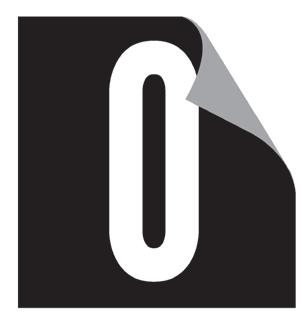
“There are some
similarities to last year’s team, but this group so far…they go hard in prac tice, they are an impressive group…We are bigger than I remember us and just as fast.”
The speed and size are not the only pieces Jackson noticed. This year’s team features a hunger that last year’s team did not.
“Any time you don’t get to the Frozen Four or win a championship, yeah, there should be some hunger. They were close. That team was very close to getting to the Frozen Four, and any time you get there, any thing is possible. And that core of that team is back.”
The hunger that Jackson noticed in his team came from the squad’s shortcom ings in the nc AA r egional Finals last year. After n otre d ame beat n orth d akota in o T 2-1, the team faced m innesota s tate in the r egional Finals. The Irish ultimately came up short against the m avericks in a hard-fought game, with the m avericks advanced to the Frozen Four n ational c hampionship game, where they then lost to d enver.
c oach Jackson praised
the team’s overall depth, highlighting some new de fensive players who would bolster the team’s defense.
o ne such player was b en b rinkman, a grad student defensman who transferred from m innesota to play for the Irish. b rinkman, draft ed by the d allas s tars in 2019, was a cornerstone of the Gophers’ defense, play ing in 140 games during his time at m innesota.
The other transfer men tioned, junior d rew b avaro, transferred from b entley. b avaro was a huge part of the b entley offense, boast ing nine goals and leading the team in assists with 27 points.
Jackson also highlighted a few returning core defen sive players. The first men tioned was Grad s tudent n ick Leiverman, who played in 34 games, earn ing 27 points and a second team-best plus/minus of 16.
The next player men tioned was junior Zach Plucinski. While Plucinski may not have b avaro or Leiverman’s statistical resume, he played in 32 games for the Irish last
Leivermann ready for regular season
By NATE MOLLER senior sports WriterGraduate student defender nick Leivermann is prepared to lead the eighth-ranked Irish this season starting this Friday against denver.
Leivermann has been an in tegral part of the Irish defense over the course of the last few seasons, and last season he recorded a team-leading 21 assists.
Although Leivermann and the Irish lost to the United states national Team development Program (UsnTdP) U18 team in sunday’s exhibition, he is confident in his team ahead of the start to the regular season.
“We feel really good heading into the season. We obviously don’t want to pay too much at tention to the preseason rank ings, but we know we belong probably in the top-five based on our year last year, and what we brought in this year, so we are excited,” Leivermann said.
Leivermann felt that sunday’s game was a good opportunity to improve as a team and get some real game experience.
“It’s always good to get this game in early.” Leivermann said, “I think that’s why our coaches want to do it so that we can work some stuff out early.”
Leivermann was disappointed
with the loss on sunday night, but he thought sunday was a great opportunity to get young er players some much needed playing time.
“obviously you want to win that game, and losing to that team two years in a row is never fun,” Leivermann said.
“Winning is the number one goal, but it’s also about getting new guys in and getting a feel ing for what our team is going to be this year.”
The Irish are typically a de fensive oriented team, but Leivermann was encouraged by the team’s movement of the puck on the offensive end on sunday night.
“We moved the puck really well in the offensive zone, which is good to see. We are a team that is always trying to bet ter ourselves on that end of the ice because normally we are more of a defensive type team.” Leivermann said.
despite the positives from sunday, the Irish surrendered some costly penalties that ulti mately lost them the game.
Leivermann felt that the Irish gave the U18 team too much space and time during their power plays on sunday.
“We just really weren’t intense enough tonight, and giving some
